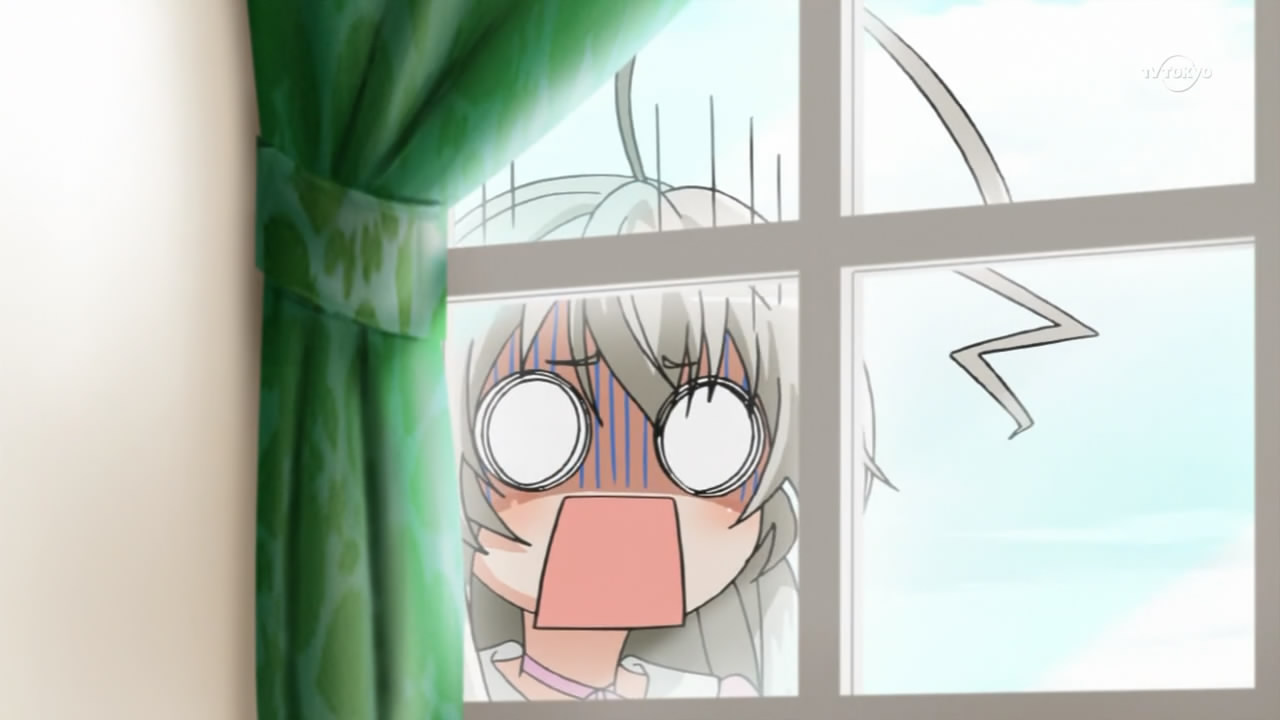Haiyore! Nyaruko-san Episode 11 References
"I'm going to finish first!" (0:29)
"Huh? I can't drift!" (0:32)
"Who just threw that shell?" (0:35)
"The banana! The banana!" (0:39)
The game being played is referencing "Mario Kart 64" (マリオカート64), a video game released by Nintendo (任天堂) in 1996. The lines in this scene are referencing various aspects of this game.
* Drifting is one element of the game's mechanics.
* Shells are items that can be picked up during the race and thrown at other racers to temporarily stun them.
* Bananas are items that can be picked up during the race and thrown onto the race track. A racer that drives into a banana will temporarily spin out of control.
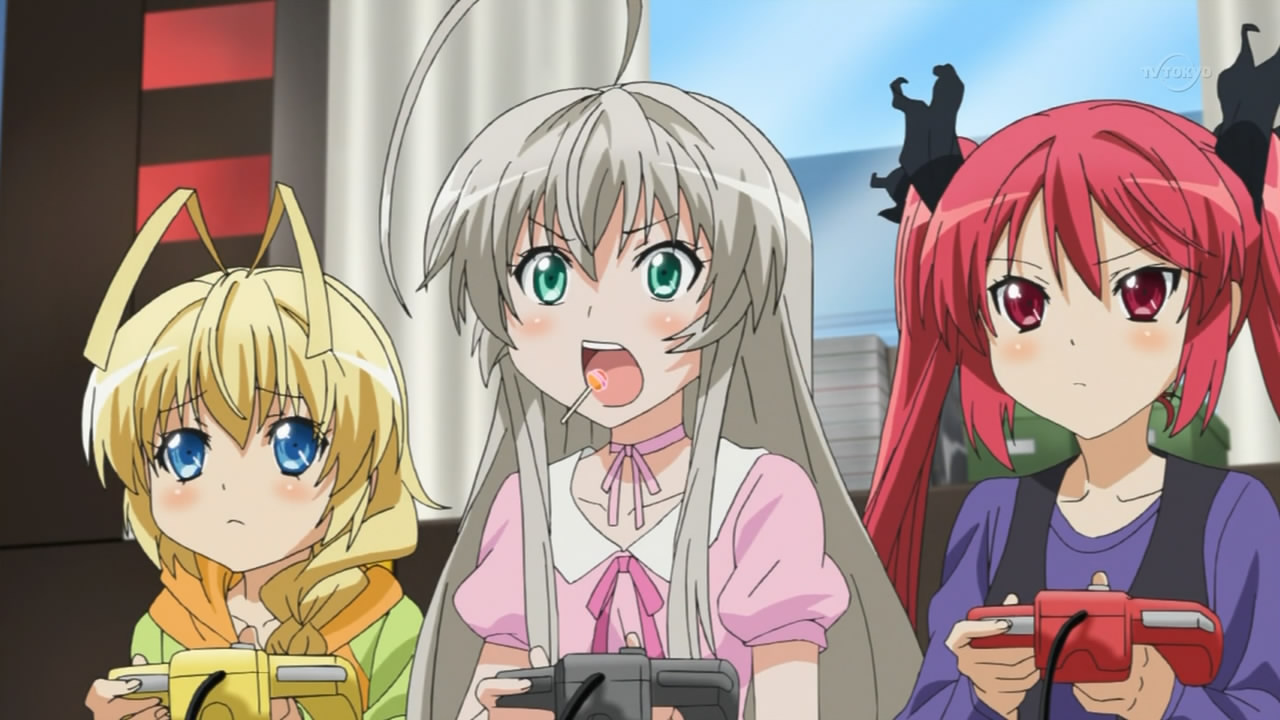
(0:33)
The controllers that Nyaruko and company are using are based on the controller for the Nintendo 64 (ニンテンドウろくじゅうよん), a video game console released by Nintendo (任天堂) in 1996. Image for reference:

Source of image: https://en.wikipedia.org/wiki/File:N64-Console-Set.png
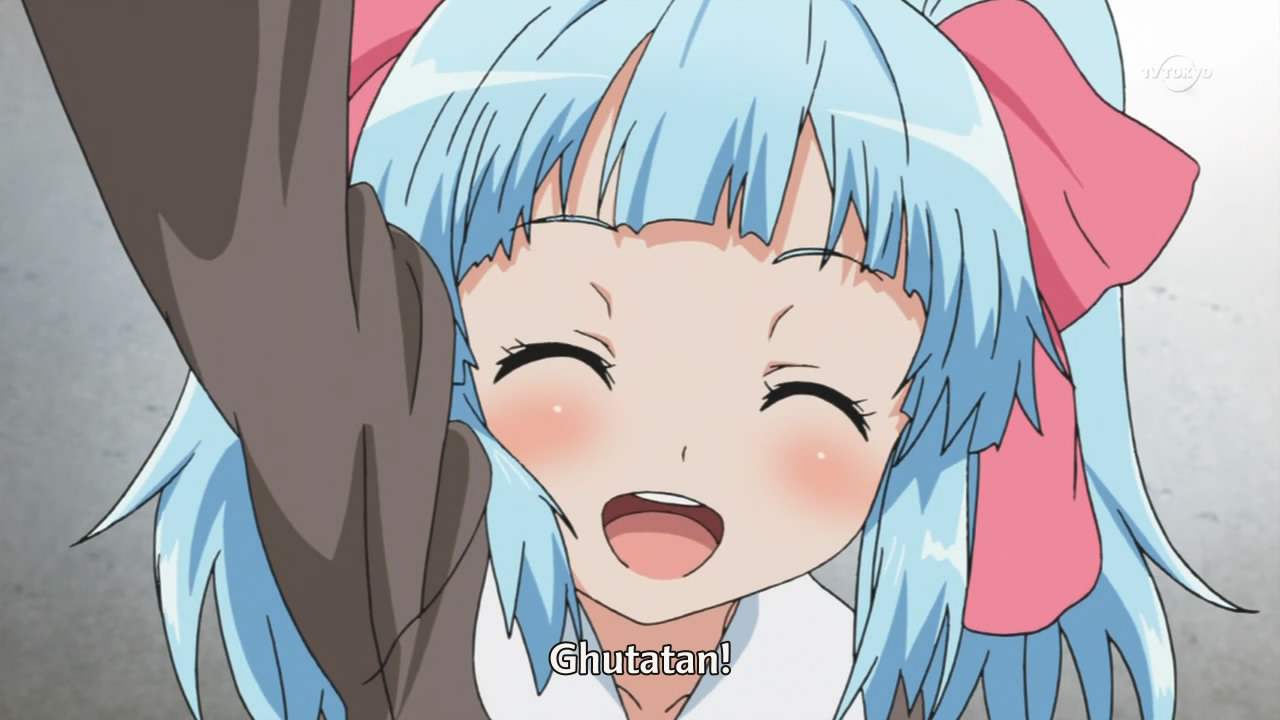
"Ghutatan!" (1:51)
"This is the young lady of the Ghatanothoa Conglomerate, Ghutatan." (2:05)
There are four references here:
* Ghutatan and the Ghatanothoa Conglomerate are based on Ghatanothoa, a creature classified as a Great Old One in the Cthulhu Mythos. It first appeared in "Out Of The Aeons", a short story written by H. P. Lovecraft and Hazel Heald and first published in 1935.
* The name "Gutatan" (グタタン), "Ghutatan", is based on "Gutanta" (グタンタ), "G'tanta", another name Ghatanothoa is known by that is mentioned in "Out of The Aeons".S4
* Ghutatan's pose here with her hand raised is likely referencing Akaza Akari (赤座あかり) from "YuruYuri" (ゆるゆり), an anime series that aired in 2011. Akari makes this pose at the beginning of most episodes this series. The likely connection here is that the person who voices Ghutatan, Mikami Shiori (三上枝織), also voices Akari. Image for reference:
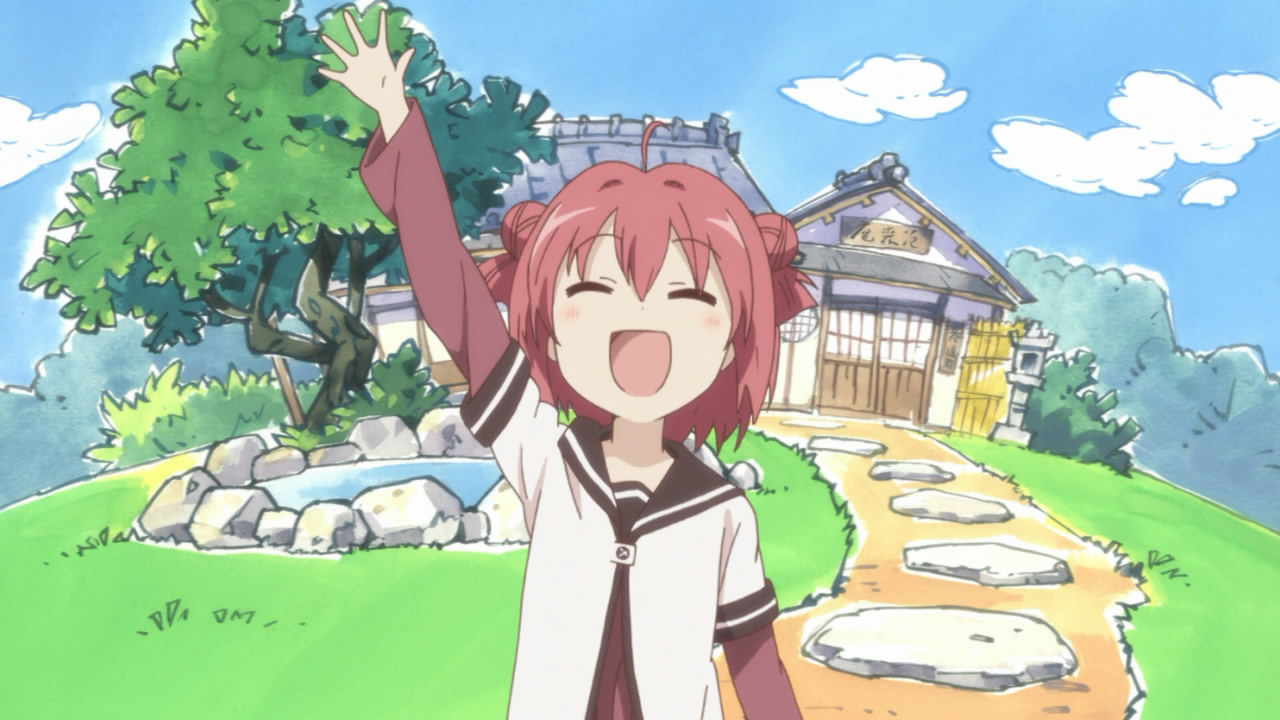
* Ghutatan's spiral hair style appears to be referencing the appearance of Gatanozoa (ガタノゾーア) from "Ultraman Tiga" (ウルトラマンティガ), a Japanese TV show about a super hero from outer space that aired from 1996 to 1997. In the show, Gatanozoa has a spiral-shaped shell. In addition, Gatanozoa is based on Ghatanothoa from the Cthulhu Mythos.S1 Image for reference:
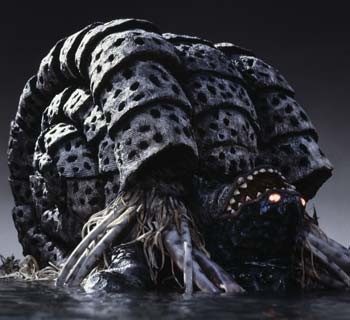
Source of image: http://ultra.wikia.com/wiki/Gatanozoa

"I am her butler, Roy Fogger, the Lloigor." (2:08)
"Please call me Major." (2:16)
There are two references here:
* Lloigor is a species of creature that serve Ghatanothoa in the Cthulhu Mythos. In "The Return of the Lloigor", a story written by Colin Wilson and first published in 1969, they are described as follows:
"These latter, he said, were definitely aliens on our earth, and the chief among them was called Ghatanothoa, the dark one."* The name Roy Fogger (ロイ・フォガー) is referencing Roy Focker (ロイ・フォッカー) from "Chou Jikuu Yousai Makurosu" (超時空要塞マクロス) "Super Dimension Fortress Macross", an anime series that aired from 1982 to 1983.S1 In addition, Roy Fogger asking to be called "Shousa" (少佐), "Major", appears be referencing how Roy Focker has the rank of major.
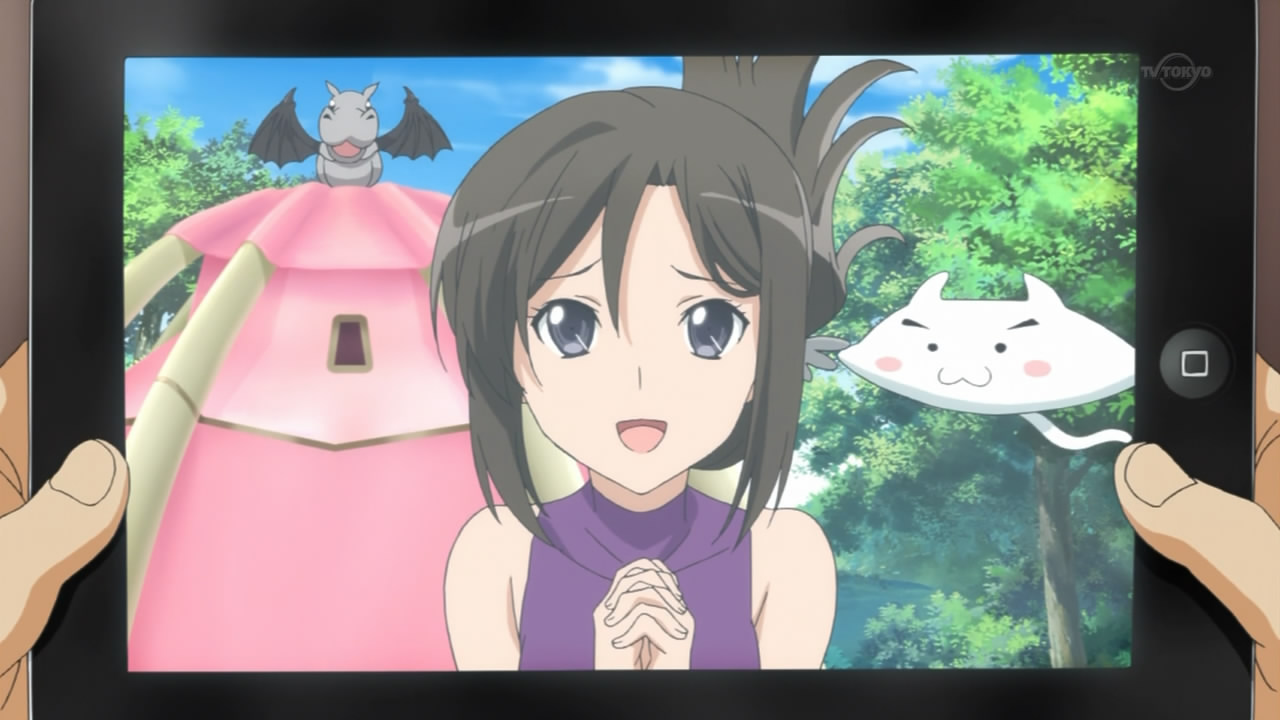
(4:03)
There are three references here:
* The white creature on the right is the Twitter profile picture of Aisora Manta (逢空万太), the author of the "Haiyore! Nyaruko-san" light novel series. Screen capture for reference:

* The device Mahiro is holding is based on the iPad, a tablet computer released by Apple in 2010. Image for reference:

Source of image: https://en.wikipedia.org/wiki/File:1stGen-iPad-HomeScreen.jpg
* The tent in the background is based on a tent that appears in "Monster Hunter" (モンスターハンター), a video game released by CAPCOM (カプコン) in 2004.S1 Image for reference:
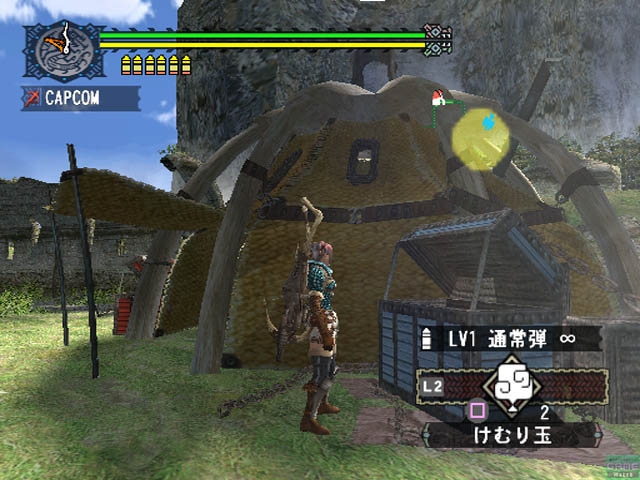
Source of image: http://game.watch.impress.co.jp/docs/20040219/mon12.htm
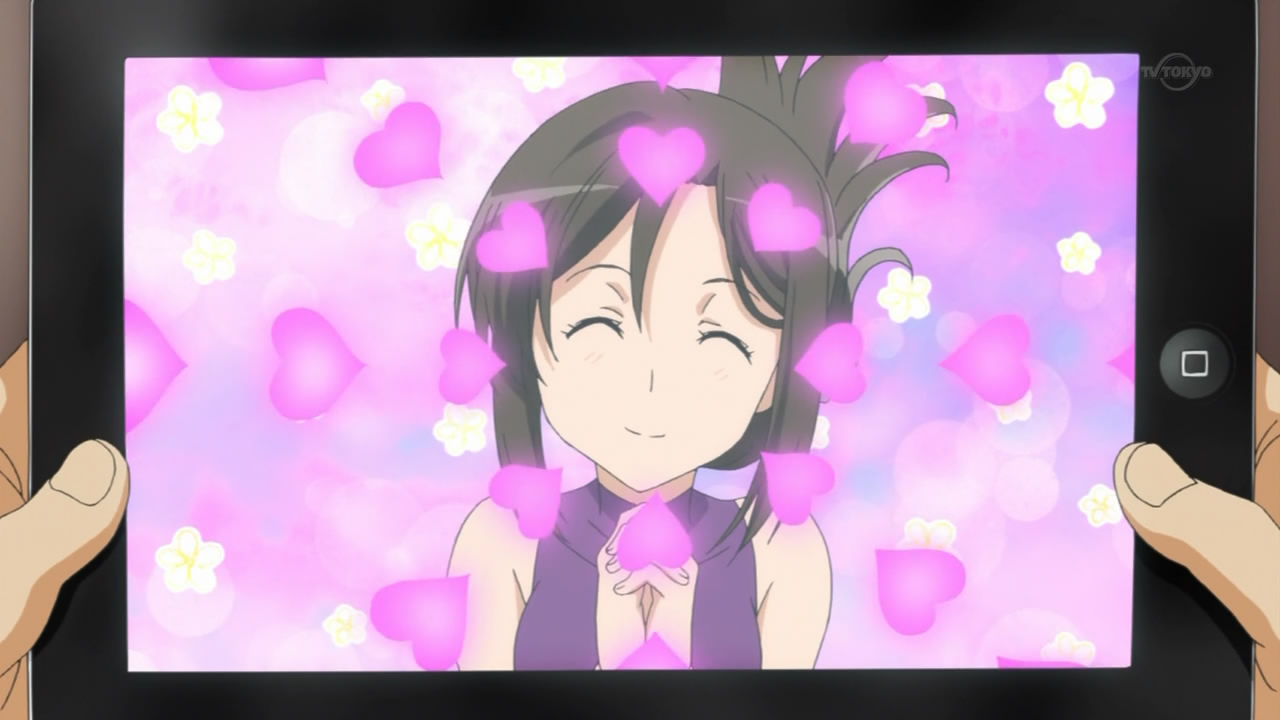
"Please." (4:18)
The Japanese line is "onegai" (おねがい). This line, Yoriko's pose, and the hearts flying out in 8 directions from her face are referencing My Melody (マイメロディ) from "Onegai Mai Merodi" (おねがいマイメロディ), "Please My Melody", an anime series that aired from 2005 to 2009.S1 Sometimes when My Melody asks someone to do something for her she will say "onegai" (おねがい) and clasp her hands together while tilting her head, and then hearts will fly out in 8 directions from her face. Image for reference:
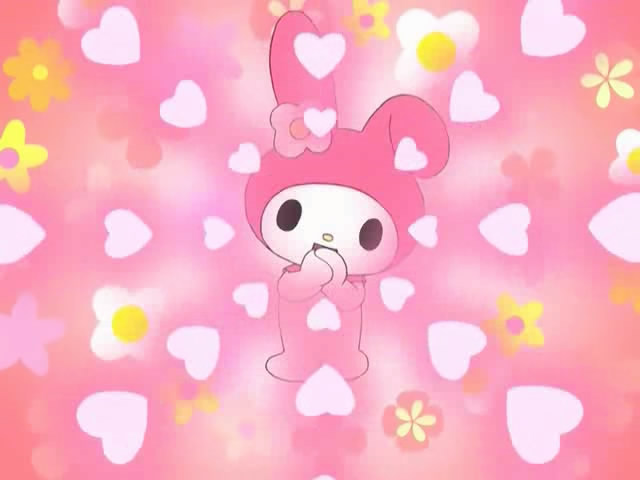
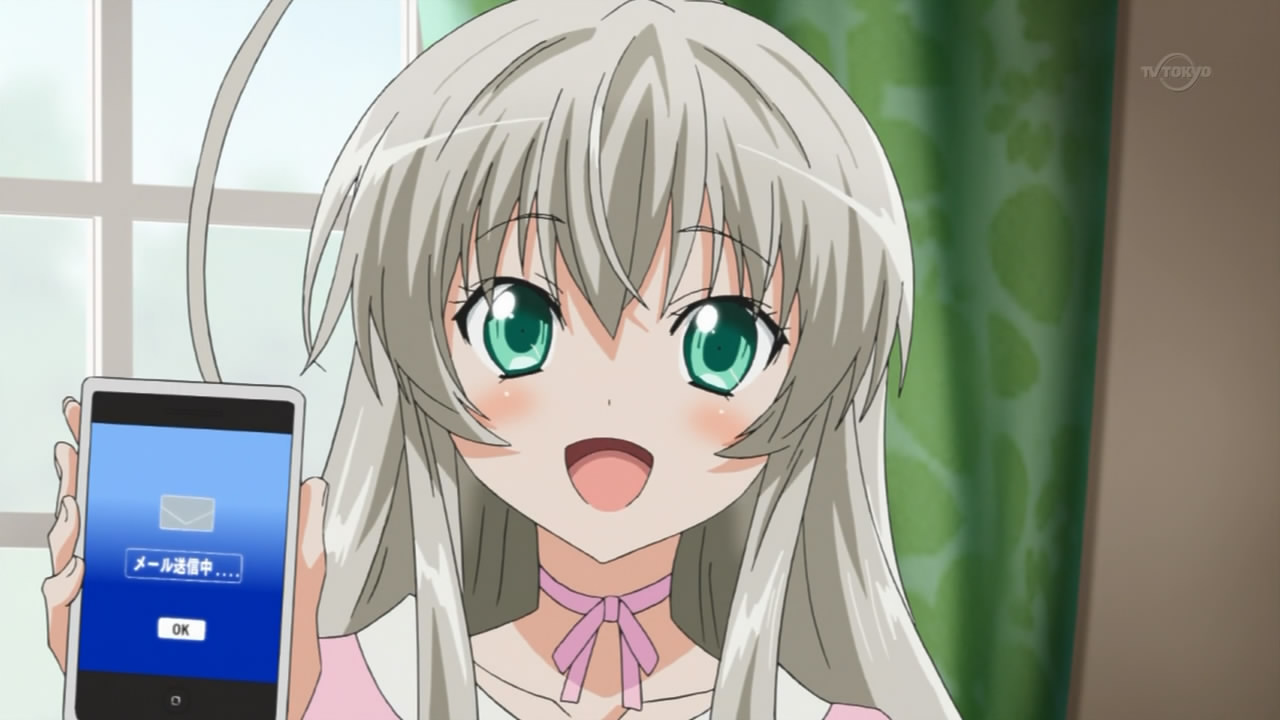
(4:39)
The phone Nyaruko is holding is based on the iPhone, a smart phone released by Apple in 2007. Image for reference:

Source of image: https://en.wikipedia.org/wiki/File:IPhone_4_Mock_No_Shadow_PSD.png
"I nyow!" (5:00)
"I nyew it." (5:31)
The Japanese line is "Nyaruhodo!" (にゃるほど!). This is using the Japanese term "naruhodo" (なるほど), which generally means "I understand", and changing the sound of the first syllable to "nya" to make it sound Nyaruko-like. "Nyaruhodo" is an often used word on "Nyaruraji" (にゃるラジ), a web radio show about "Haiyore! Nyaruko-san" that is hosted by Asumi Kana (阿澄佳奈) and Matsuki Miyu (松来未祐), the voice actors of Nyaruko and Cthuko respectively.S2 For example, the word was mentioned in episodes 3, 4, and 6 of "Haiyoru Nyaruraji -OMEGA-" (這いよるにゃるラジ-OMEGA-), the second season of the web radio series that aired in 2010.
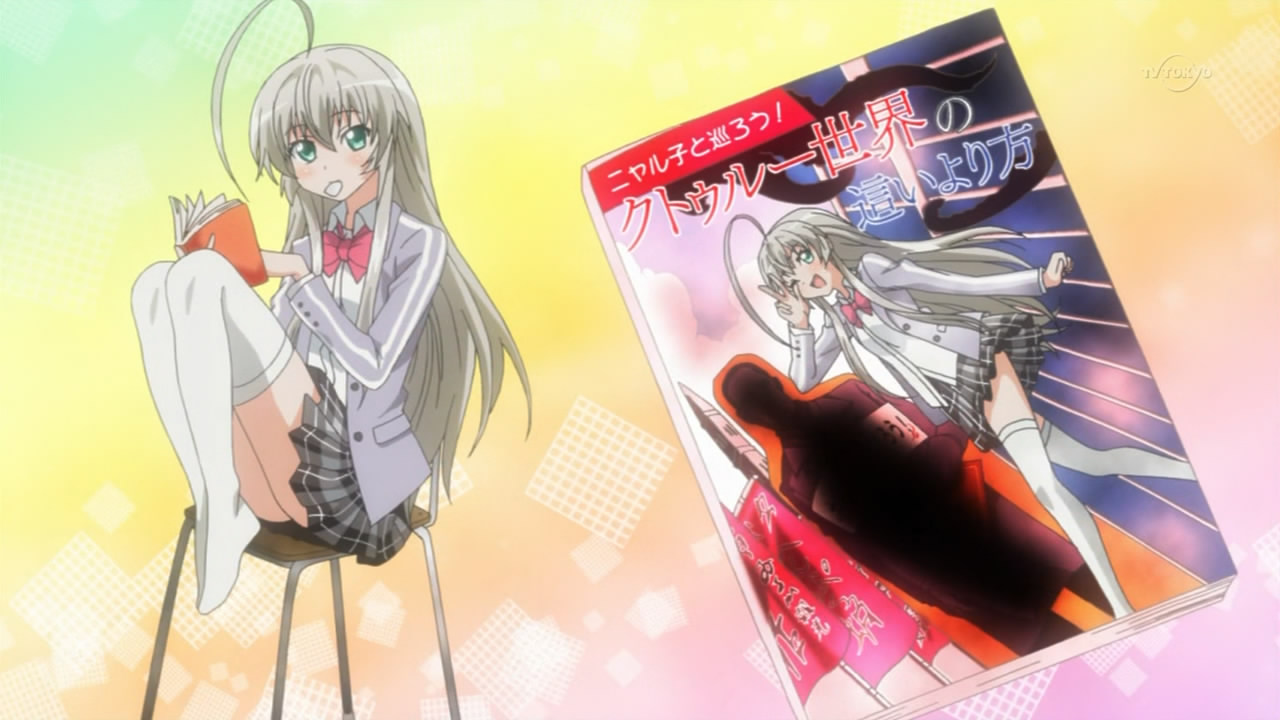
(5:04)
There are two references here:
* Nyaruko's pose on the left is referencing that of Amano Touko (天野遠子) on the cover of volume 1 of "Bungaku Shoujo" (文学少女), "Literature Girl", a light novel series written by Nomura Mizuki (野村美月) and published from 2006 to 2011.S2 Image for reference:

Source of image: https://bookwalker.jp/de6ebac425-8292-4b79-894f-3d096412e9b2/
On a related note, Cthulhu is mentioned in volume 5 of this series.S4
* The title of book on the right is "Nyaruko to Megurou! Kutouruu Sekai no Haiyori Kata" (ニャル子と巡ろう! クトゥルー世界の這いより方), which translates to "Let's Sight See with Nyaruko! How to Crawl Through the World of Cthulhu". The title and the cover art are referencing those of "Moe E de Meguru! Kutouruu Sekai no Aruki Kata" (萌え絵で巡る! クトゥルー世界の歩き方), "Sight See Through Cute Pictures! How to Walk Through the World of Cthulhu", a book published in 2011 that contains illustrations of elements from the Cthulhu Mythos.S2 (Thanks convexity for translation help) Image for reference:
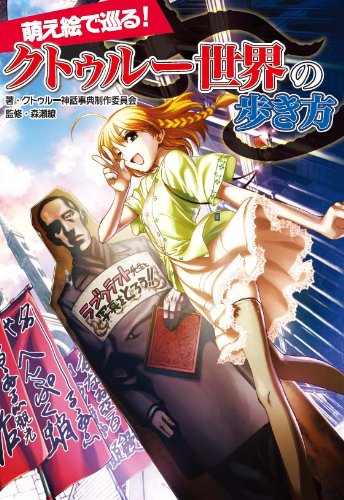
Source of image: http://www.amazon.co.jp/dp/4861994039
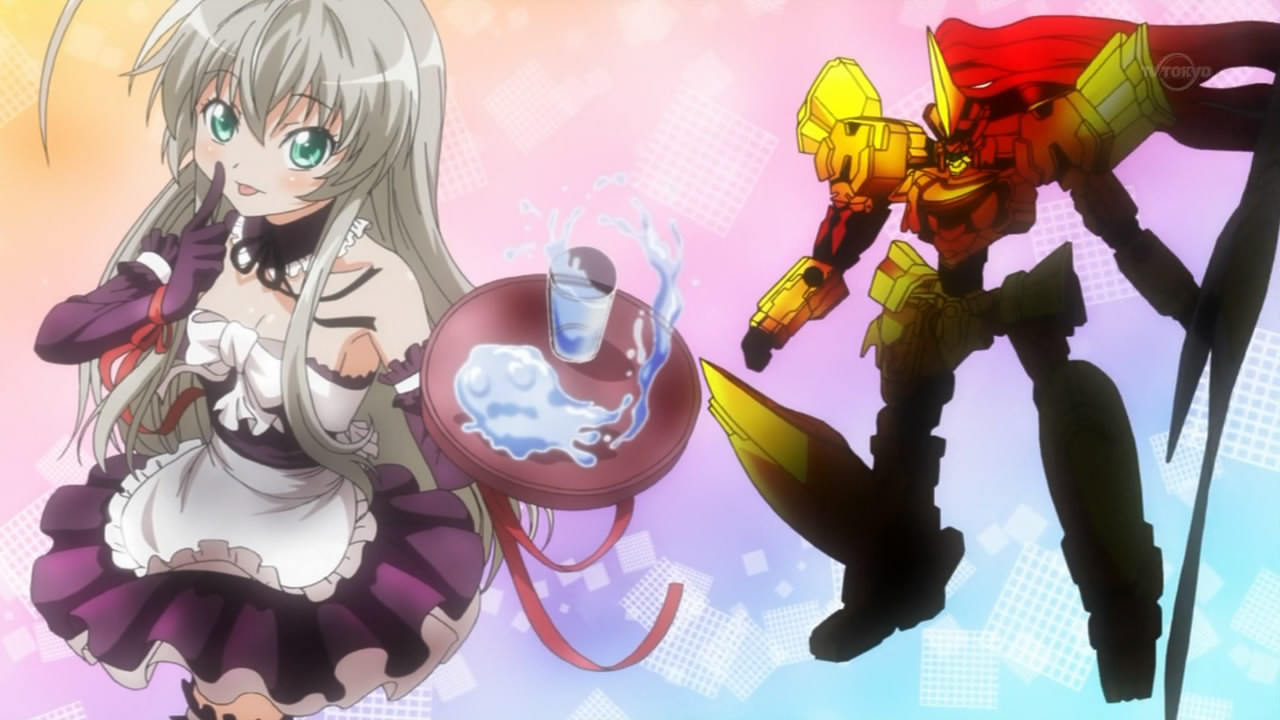
(5:07)
There are two references here:
* Nyaruko's outfit and pose on the left are referencing those of Ruie Ruru (流家ルル) in an illustration in volume 2 of "Makai Shoujo Ruruie Ruru" (魔海少女ルルイエ・ルル), "Girl From the Demonic Sea Ruruie Ruru", a light novel series written by Hazawa Kouichi (羽沢向一) and published in 2010.S1 Image for reference:
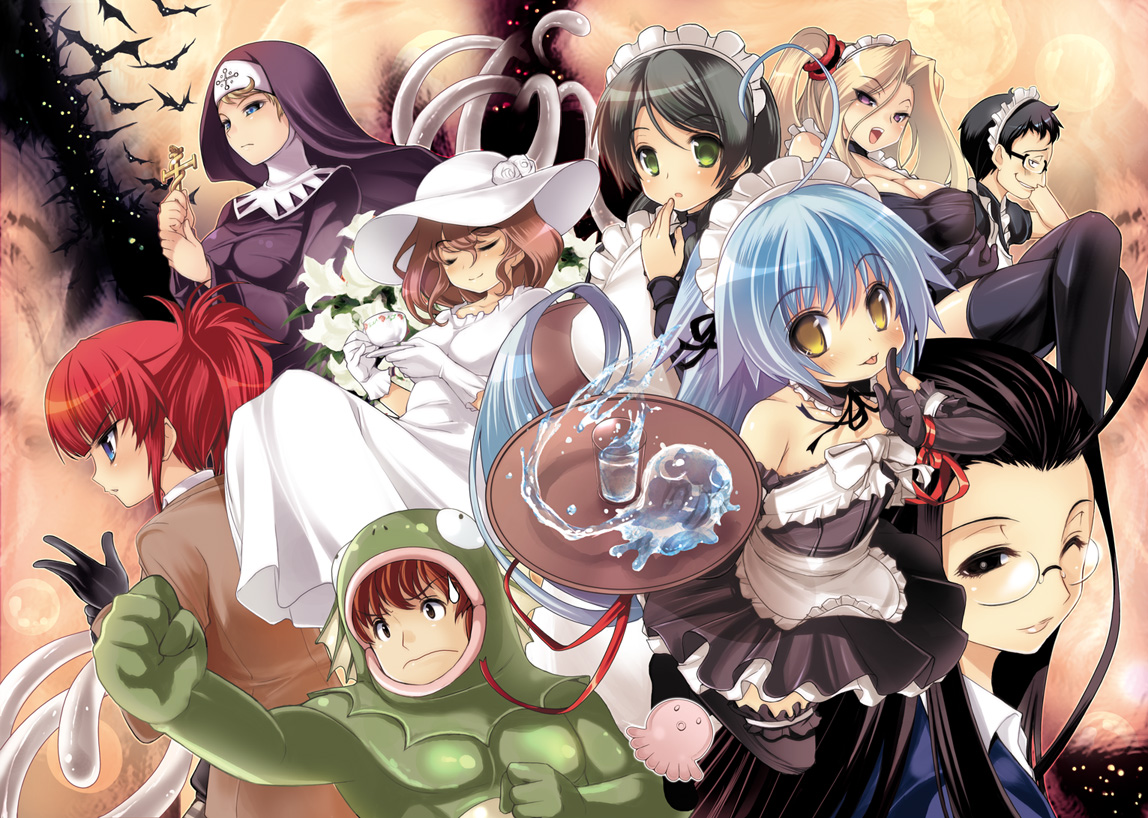
Source of image: http://yoridorigreen.sakura.ne.jp/illust/ruru2.html
* The robot that appears on the right is based on Demonbane (デモンベイン) from "Zanma Taisei Demonbein" (斬魔大聖デモンベイン), "Deus Machina Demonbane", a visual novel based on the Cthulhu Mythos that was released by Nitroplus (ニトロプラス) in 2003. Image for reference:
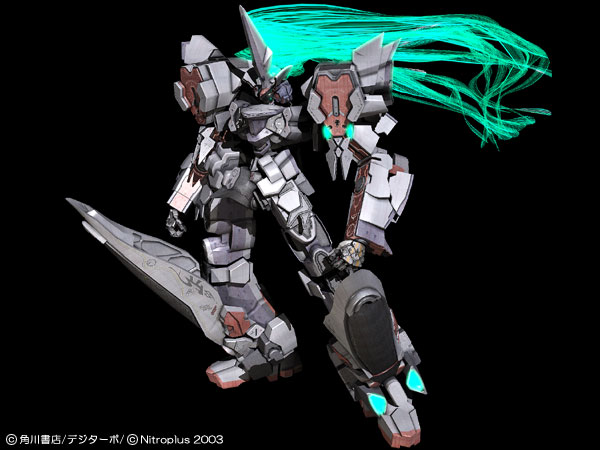
Source of image: http://www.demonbane.com/special2/machine01.html
On a related note, the person who voices Roy Fogger, Nakata Jouji (中田譲治), also voices Titus (ティトゥス) in this visual novel.
"From artistic high school girls to nudists" (5:08)
There are two references here:
* "Artistic high school girls" is referencing Yuno (ゆの) from "Hidamari Sukecchi (ひだまりスケッチ), "Hidamari Sketch", a manga series written by Aoki Ume (蒼樹うめ) and first published in 2004. Yuno is a high school student who is attending an art school and dreams of being a great artist. In the anime adaptation of "Hidamari Sketch" Yuno is voiced by Asumi Kana (阿澄佳奈), the same voice actor who voices Nyaruko.S1
* "Nudists" is referencing Kitahara Mio (北原美桜) from "Ano Natsu de Matteru" (あの夏で待ってる), "Waiting in the Summer", an anime series that aired in 2012. Mio is a nudist and is also voiced by Asumi Kana.S1
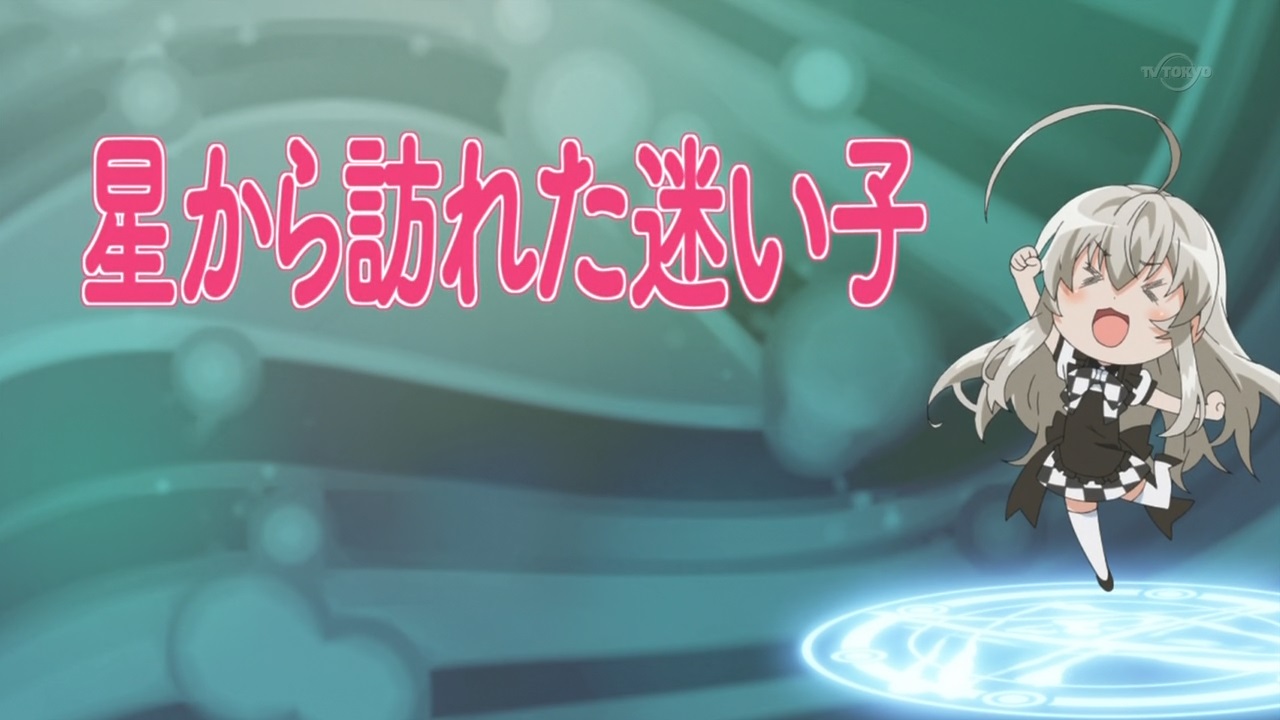
(5:52)
The title of this episode is "Hoshi kara otozureta mayoigo" (星から訪れた迷い子), which translates to "The Lost Girl from the Stars". This is referencing "The Shambler from the Stars", a short story written by Robert Bloch and first published in 1935. This story was translated into Japanese with the title "Hoshi Kara Otozureta Mono" (星から訪れたもの).
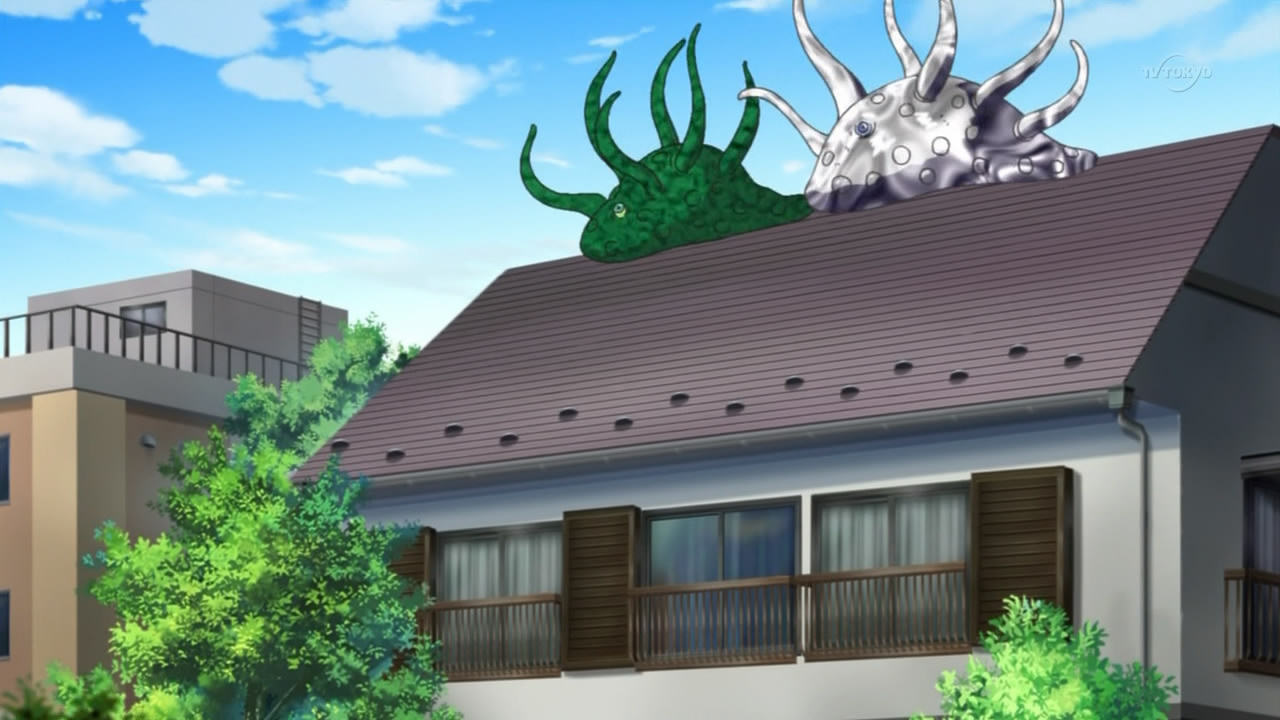
(6:00)
There are two references here:
* The creatures that appear here are Shoggoths, a species of creature in the Cthulhu Mythos. In "At the Mountains of Madness", a story written by H. P. Lovecraft and first published in 1936, they are described as follows:
"It was a terrible, indescribable thing vaster than any subway train—a shapeless congeries of protoplasmic bubbles, faintly self-luminous, and with myriads of temporary eyes forming and unforming as pustules of greenish light all over the tunnel-filling front that bore down upon us..."On a related note, the Shoggoths repeatedly say "Tekeli-li", which is referencing how Shoggoths say this phrase in the above mentioned story.
* The Shoggoths are on a roof. This is referencing "A Shoggoth on the Roof", a musical published by the H. P. Lovecraft Historical Society in 2005 that is based on the works of Lovecraft and is a parody of the musical "Fiddler on the Roof".S1
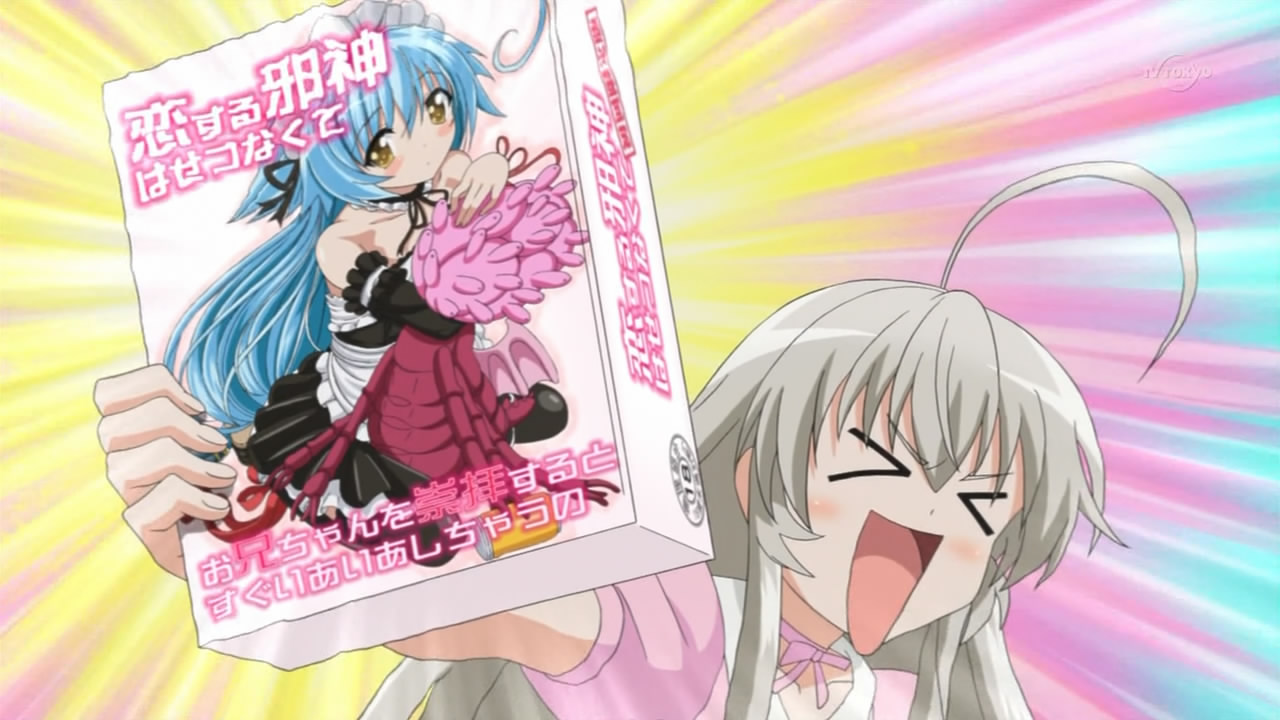
(6:13)
This is the same game that appeared in episode 1 at 7:36. There are three references here:
* The cover art of the package is based on the cover art of volume 2 of "Makai Shoujo Ruruie Ruru" (魔海少女ルルイエ・ルル), "Girl From the Demonic Sea Ruruie Ruru", a light novel series written by Hazawa Kouichi (羽沢向一) and published in 2010. Image for reference:
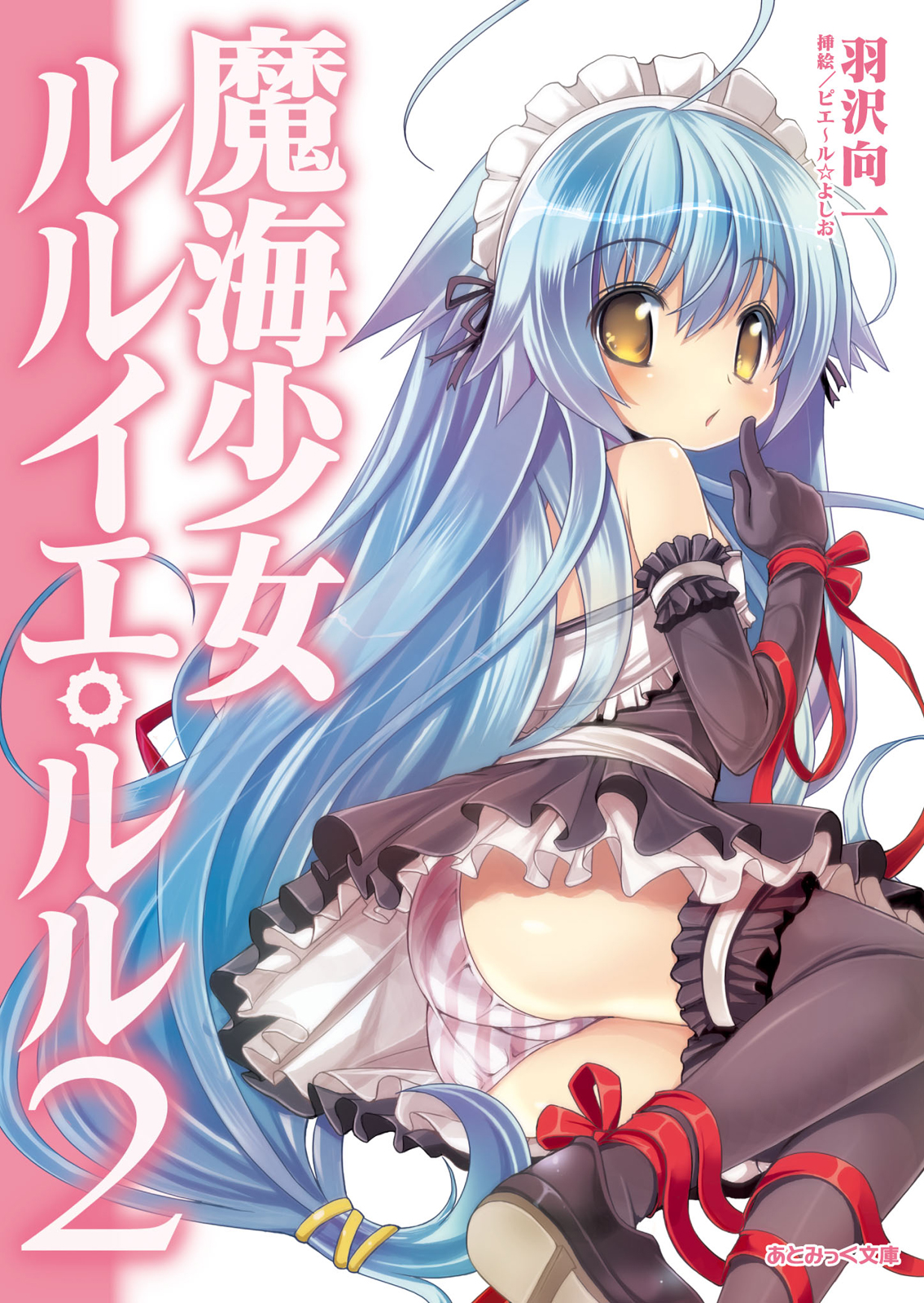
Source of image: https://bookwalker.jp/de7fbabf5d-dfc4-4c67-8169-e4dddfd058c5/
* The title of the game goes as follows:
「恋する邪神はせつなくてお兄ちゃんを崇拝するとすぐいあいあしちゃうの」"Iä" is a term that is used in the Cthulhu Mythos, often in relation to the fantastic creatures that appear in the mythos. In "The Shadow Over Innsmouth", a story written by H. P. Lovecraft and first published in 1936, a chant using the term goes as follows:
"Koi Suru Jashin ha Setsunakute Onii-chan wo Suuhai Suru to Sugu Ia Ia Shichau no"
"It's Hard to be an Evil God in Love, When I Worship Brother I Immediately Ia Ia"
"Iä! Iä! Cthulhu fhtagn! Ph’nglui mglw’nafh Cthulhu R’lyeh wgah-nagl fhtagn"The title as a whole is referencing the title of a visual novel released by CAGE in 2003. The title of this visual novel goes as follows:
「恋する妹はせつなくてお兄ちゃんを想うとすぐHしちゃうの」* The creature that the girl on the cover is hugging is a Mi-go, a species of creature in the Cthulhu Mythos. In "The Whisperer in Darkness", a short story written by H. P. Lovecraft and first published in 1931, it is stated, "They were pinkish things about five feet long; with crustaceous bodies bearing vast pairs of dorsal fins or membraneous wings and several sets of articulated limbs, and with a sort of convoluted ellipsoid, covered with multitudes of very short antennae, where a head would ordinarily be."
"Koi Suru Imouto ha Setsunakute Onii-chan wo Omou to Sugu H Shichau no"
"It's Hard to be a Little Sister in Love, When I Think of Brother I Immediately Get Aroused"
"Then I'll make us a good morning breakfast!" (7:41)
The Japanese line is "Jaa, boku ga ohayou asa gohan wo yoi suru yo" (じゃあ、僕がおはよう朝ご飯を用意するよ). This is referencing "Ohayou!! Asa Gohan" (おはよう!!朝ご飯), "Good Morning!! Breakfast", a song sung by Nigo Miyako (仁後真耶子) as Takatsuki Yayoi (高槻やよい) and released in 2005.S2 This song is used in "THE IDOLM@STER" (アイドルマスター), a video game developed by Metro (メトロ) and published by Namco (ナムコ) in 2005. On a related note, Hasta's voice actor, Kugimiya Rie (釘宮理恵), also voices Minase Iori (水瀬伊織), another character from "THE IDOLM@STER".
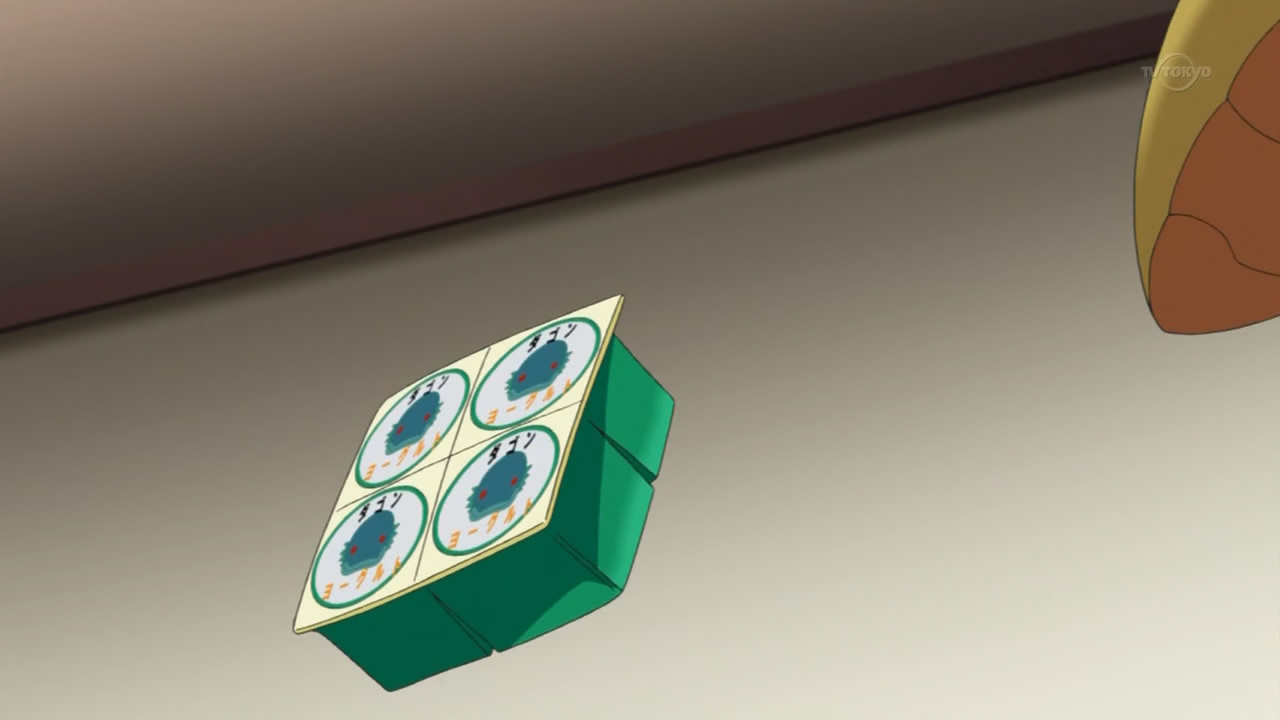
(8:04)
The text on the package reads "Dagon Yooguruto" (ダゴン ヨーグルト), "Dagon Yogurt", which is a reference to Dagon, a sea dwelling creature and a servant of Cthulhu in the Cthulhu Mythos.S1 Here is an isolation that might be easier to read:
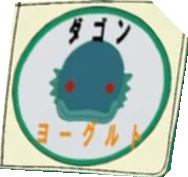
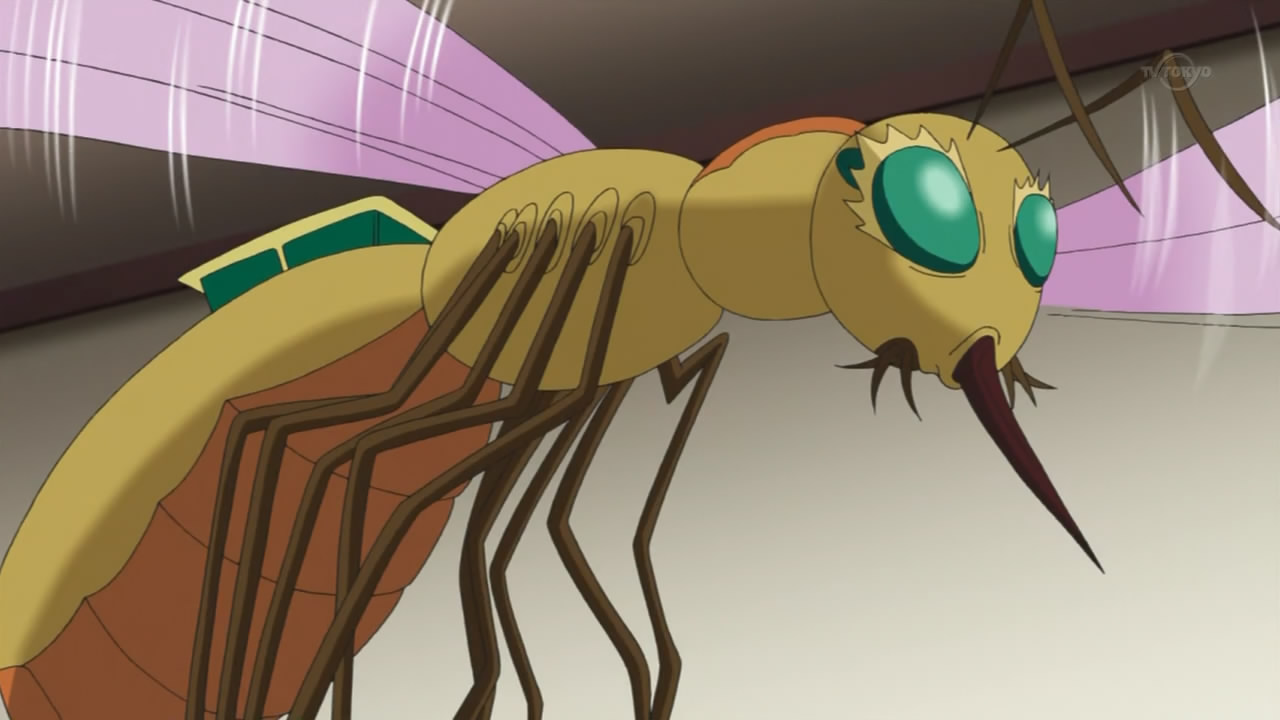
"They're insects from Shaggai." (8:07)
Insects from Shaggai are a species of creature from the planet Shaggai in the Cthulhu Mythos.
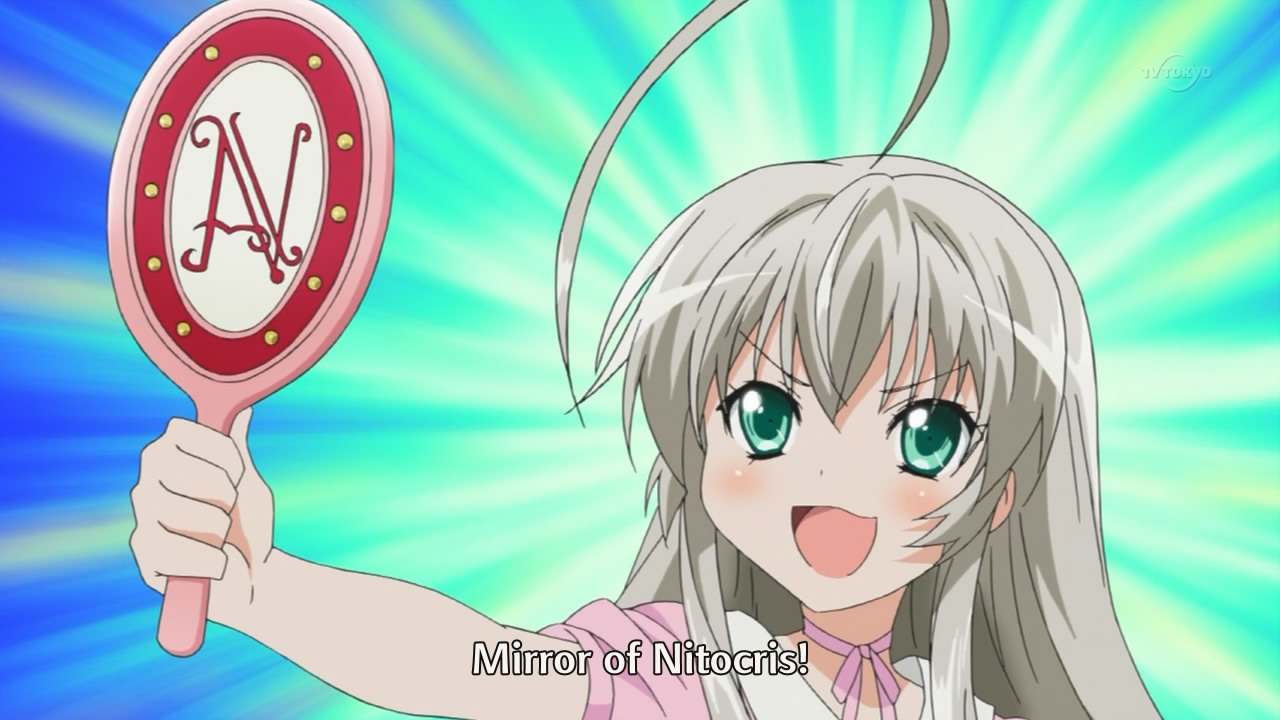
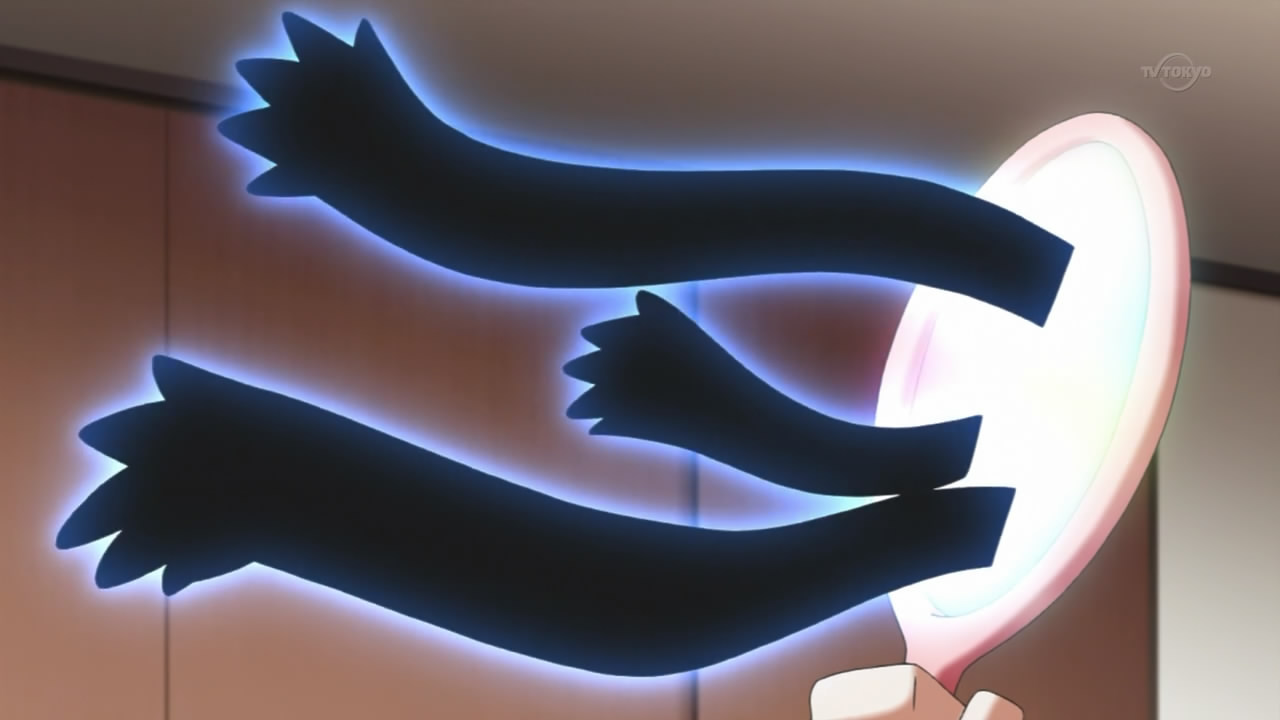
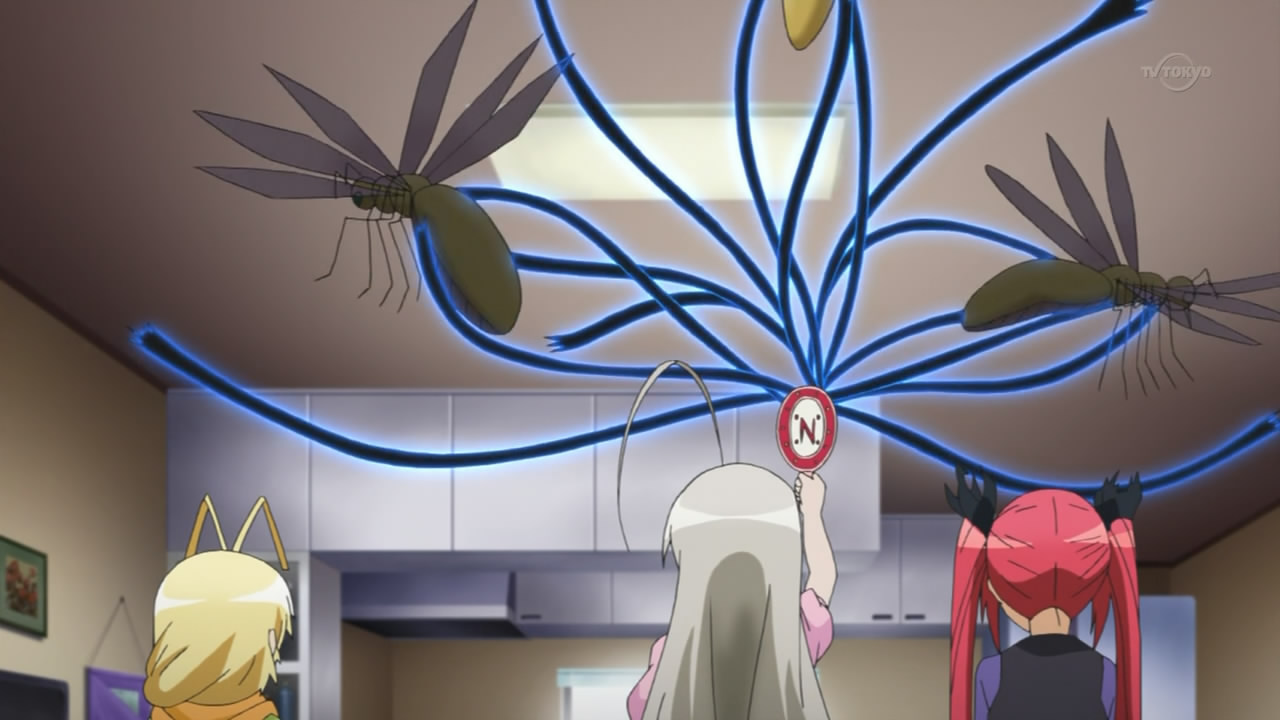
"Mirror of Nitocris!" (8:43)
There are three references here:
* The Japanese line is "Cha ra ra cha ccha ra! Nitokurisu no Kagami!" (チャララチャッチャラ!ニトクリスの鏡!). The way in which Nyaruko unveils the mirror is referencing Doraemon from "Doraemon" (ドラえもん), a manga series written by Fujiko F. Fujio (藤子・F・不二雄) and published from 1969 to 1996.S1 When Doraemon unveils a new gadget, often he will hold it up and say the name of the gadget, and the background will be drawn with an emphasizing effect. Image for reference:
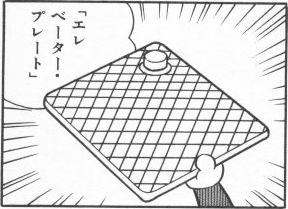
In anime adaptations of "Doraemon", typically a musical chime sound effect will be played when Doraemon unveils the gadget, which is what Nyaruko's singing is referencing.
* The appearance of the mirror is based on that of a magical compact mirror used by Kagami Atsuko (加賀美あつ子), also known as Akko (アッコ), in "Himitsu no Akko-chan" (ひみつのアッコちゃん), "The Secrets of Akko-chan", an anime series that aired from 1988 to 1989.S1 Images for reference:
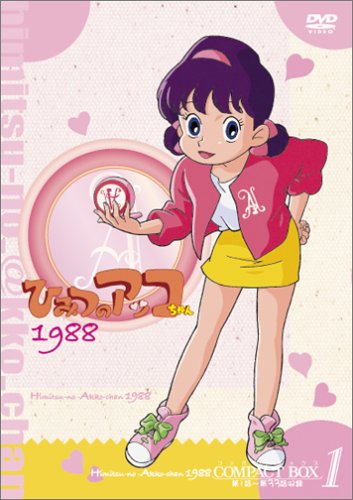
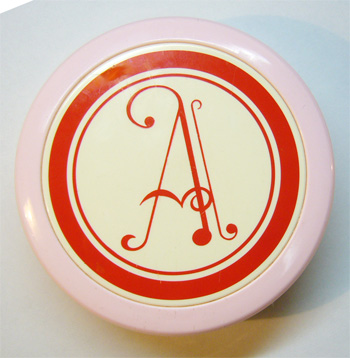
Image sources:
http://www.amazon.co.jp/dp/B0009V1D2O
http://ameblo.jp/12moya/entry-10154585050.html
* The Mirror of Nitocris is a magical mirror that appears in "The Mirror of Nitocris", a short story written by Brian Lumley and first published in 1971. In the story, the mirror is said to have belonged to Nitocris, an Egyptian Pharaoh, and the mirror is described as follows:
"... a 'gateway' to unknown spheres and worlds of hellish horror in the shape of a mirror."In addition, within the mirror dwells a blob like entity that can emerge from the face of the mirror at midnight. In the story, it is described as follows:
"A thing, a bubbling blasphemous shape from lunacy's most hellish nightmare, was squeezing its flabby pulp out through the frame of the mirror into my room—and it wore a face where no face ever should have been."When the entity emerges, it will attempt to drag anyone nearby into the mirror.
"It passed the Space ISO 9001 quality standard!" (9:17)
This is referencing the ISO 9001 standard, a standard of quality published by the International Organization for Standardization, abbreviated as ISO. ISO 9001 certification is granted to a company that meets the required standards. The certification requirements are intented to facilitate a good standard of quality management in companies.
"Oh? Mahiro, did you look at my Pretty Rhyth-" (9:32)
What Nyaruko was about to say is "Pretty Rhythm", which is referencing "Pretty Rhythm" (プリティーリズム), a game released by Takara Tomy (タカラトミー) and syn Sophia (シンソフィア)in 2010. It was adapted into an anime series called "Pretty Rhythm Aurora Dream" (プリティーリズム・オーロラドリーム) in 2011. In the anime series, the main character, Harune Aira (春音あいら), is voiced by Asumi Kana (阿澄佳奈), who also voices Nyaruko.
"Gyafun!" (9:48)
This is a repeat of a reference in episode 5 at 8:49. The Japanese line is "Gyafun!" (ぎゃふん!). This is a line often said by Harune Aira (春音あいら) in "Pretty Rhythm: Aurora Dream" (プリティーリズム・オーロラドリーム), an anime series that aired from 2011 to 2012. On a related note, Nyaruko's voice actor, Asumi Kana (阿澄佳奈), also voices Aira. Video for reference: https://www.nicovideo.jp/watch/sm17747657
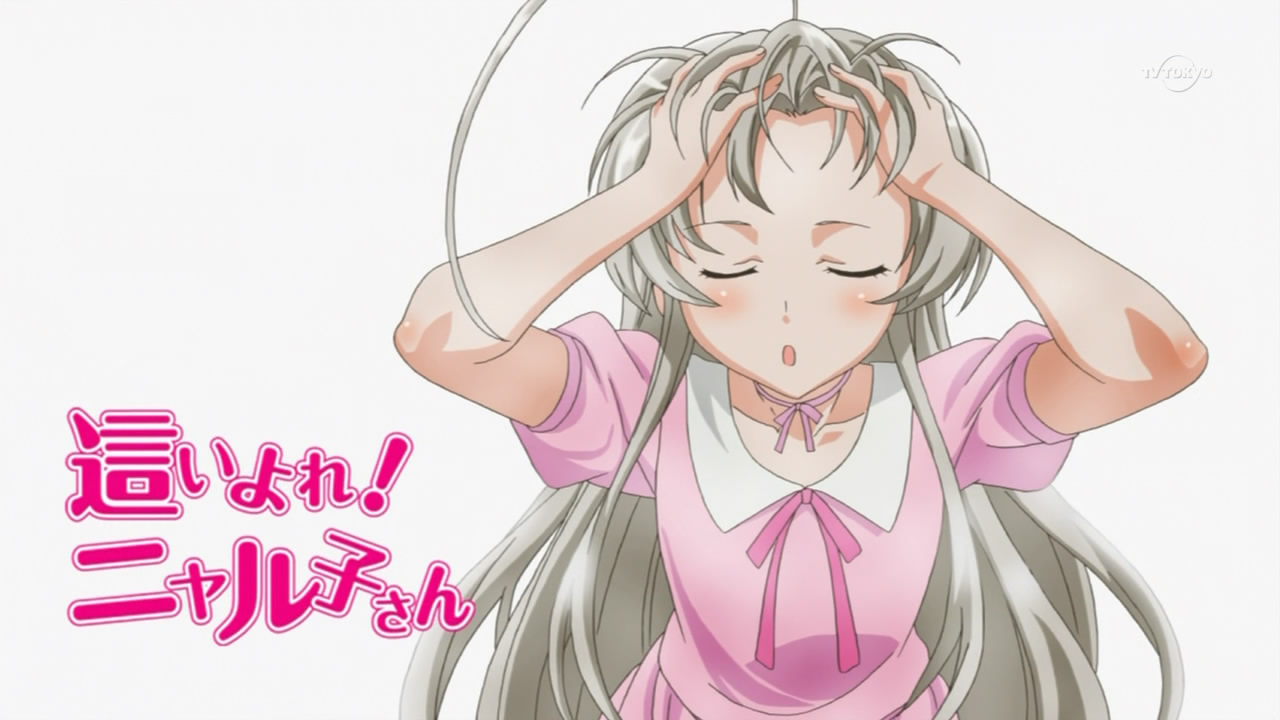
(11:39)
Nyaruko's pose is referencing that of Aihara Nana (相原菜々) from "KimiKiss" (キミキス), a dating simulation game released by Enterbrain (エンターブレイン) in 2006.S2 Image for reference:
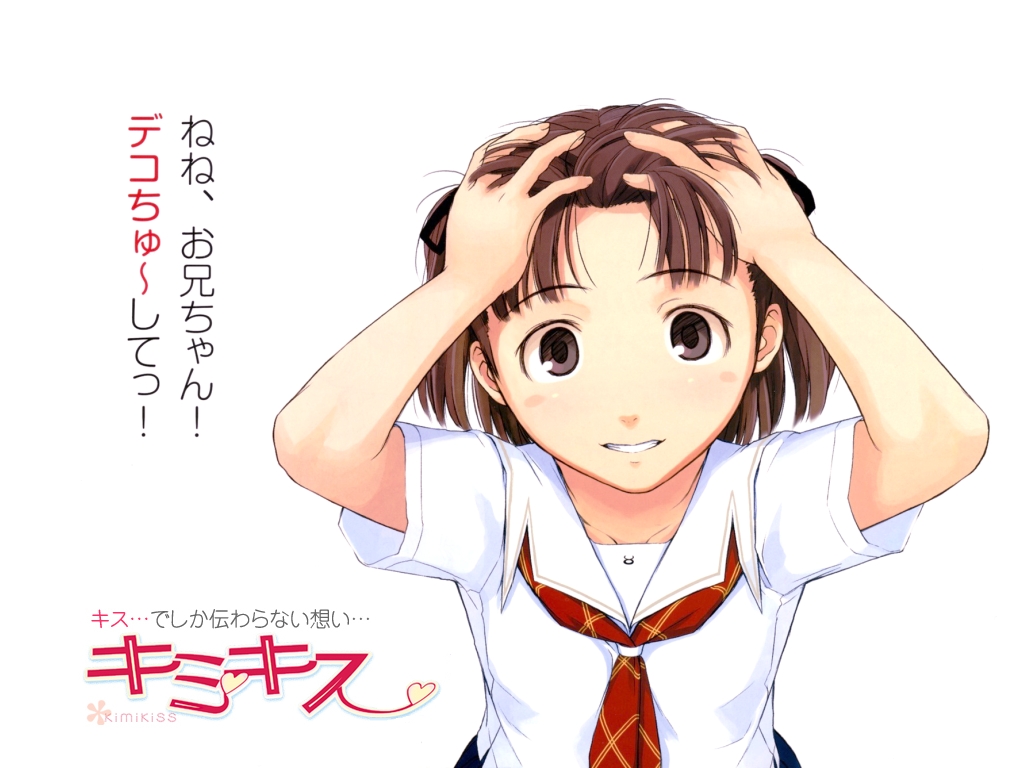
Source of image: http://lovesil.sakura.ne.jp/kimikiss/
The connection here goes as follows:
- Nana is the younger sister of the main protagonist in "KimiKiss".
- The company that developed and published "KimiKiss", Enterbrain, also developed and published "Amagami" (アマガミ), which was released in 2009. "Amagami", like "KimiKiss", is also a dating simulation game that takes place in a high school setting. In addition, both "Amagami" and "KimiKiss" share the same character designer, Takayama Kisai (高山箕犀). As a result, the games are similar to each other in terms of gameplay and visual appearance.
- In "Amagami", there is a character named Tachibana Miya (橘美也), who is the younger sister of the main protagonist.
- Nyaruko's voice actor, Asumi Kana (阿澄佳奈), also voices Miya in "Amagami". However, she does not voice Nana in "KimiKiss". Nana is voiced by Nogawa Sakura (野川さくら).
- Nyaruko's line at this time goes, "Deko chuu, deko chuu, to misekakete!" (デコちゅー、デコちゅー、と見せかけて!), which translates to "A kiss on the forehead, a kiss on the forehead, just pretending!". "Deko chuu" (デコちゅー), "kiss on the forehead", is referencing a line said by Nana. Her line goes, "Deko chuu shite!" (デコちゅ~してっ!), which translates to "Give me a kiss on the forehead!". Nyaruko states that she is "just pretending", which relates to how her pose and spoken line are not referencing a character voiced by Asumi Kana, but instead are referencing Nana. Putting it all together, Nana is similar to Miya, who is voiced by Asumi Kana, both characters appear in games that have similar gameplay and appearance, and both games were developed and published by the same company.
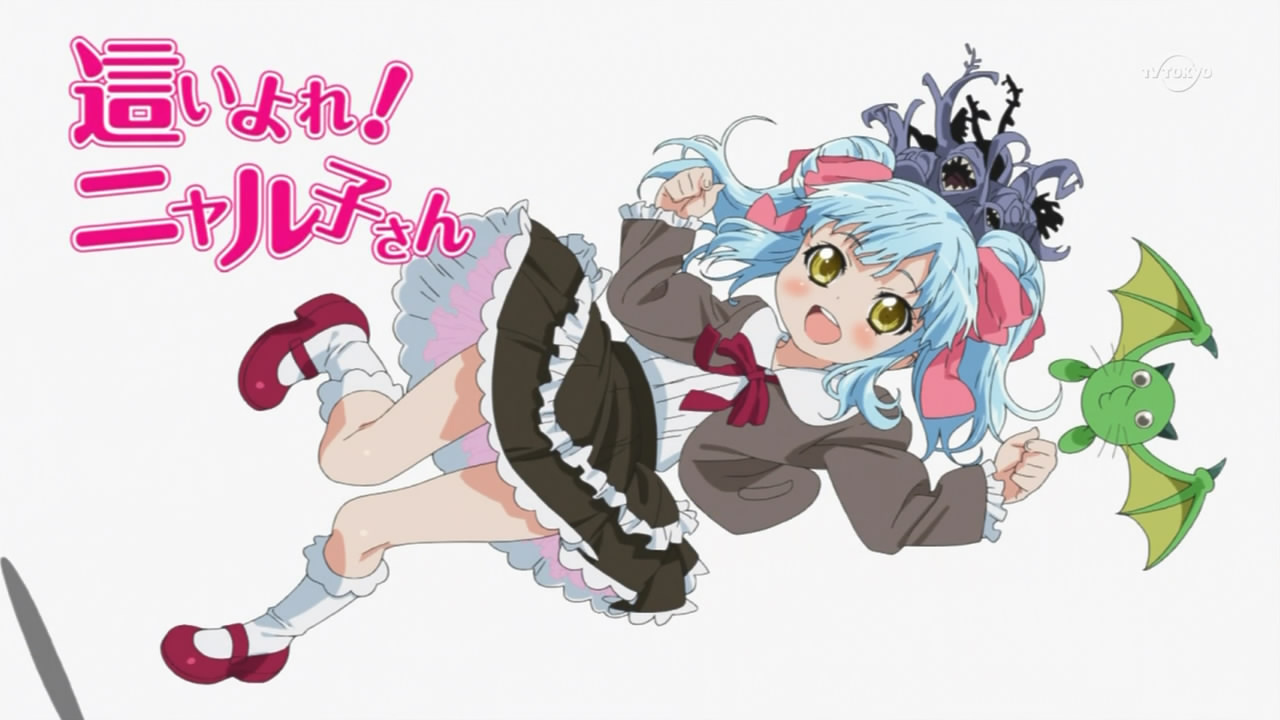
(11:44)
The creature in Ghutatan's hair is a depiction of her base character, Ghatanothoa. In "Out of the Aeons", a short story written by H. P. Lovecraft and Hazel Heald and first published in 1935, it is described as follows:
"... gigantic—tentacled—proboscidian—octopus-eyed—semi-amorphous—plastic—partly squamous and partly rugose..."
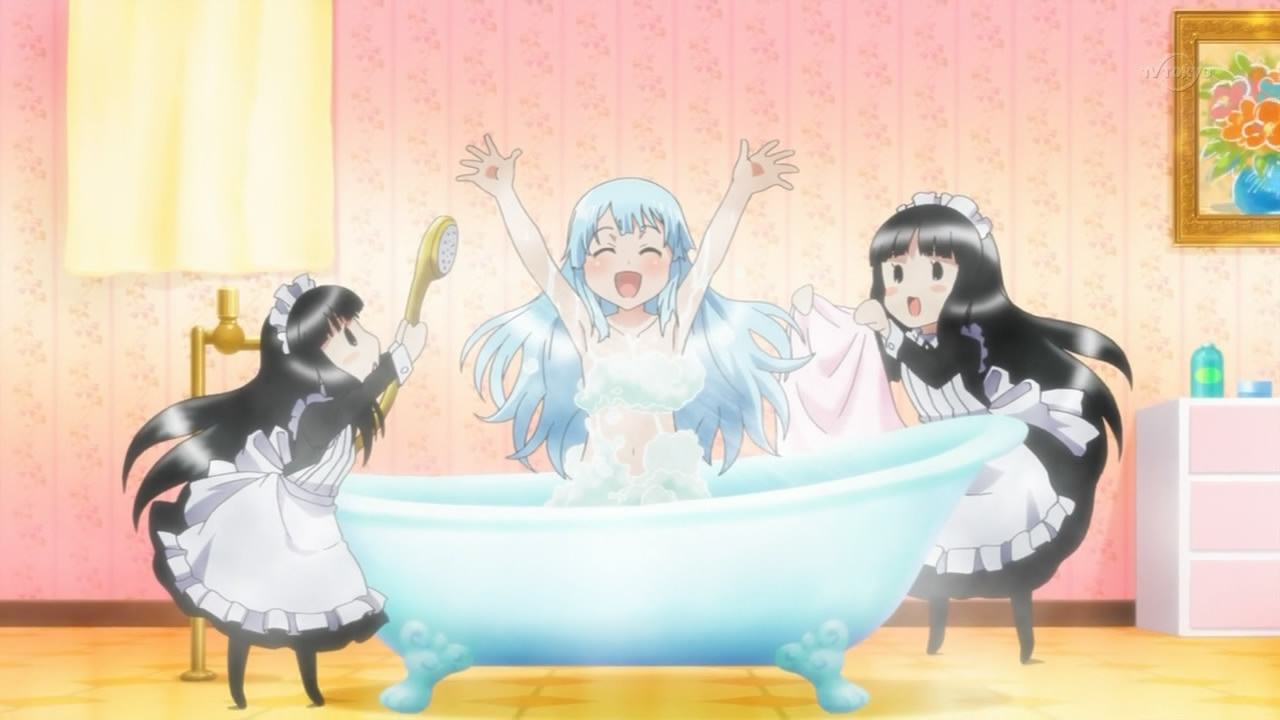
(12:00)
The maids that appear here are based on an illustration on page 271 of volume 6 of the "Haiyore! Nyaruko-san" light novel series.S3 Image for reference:
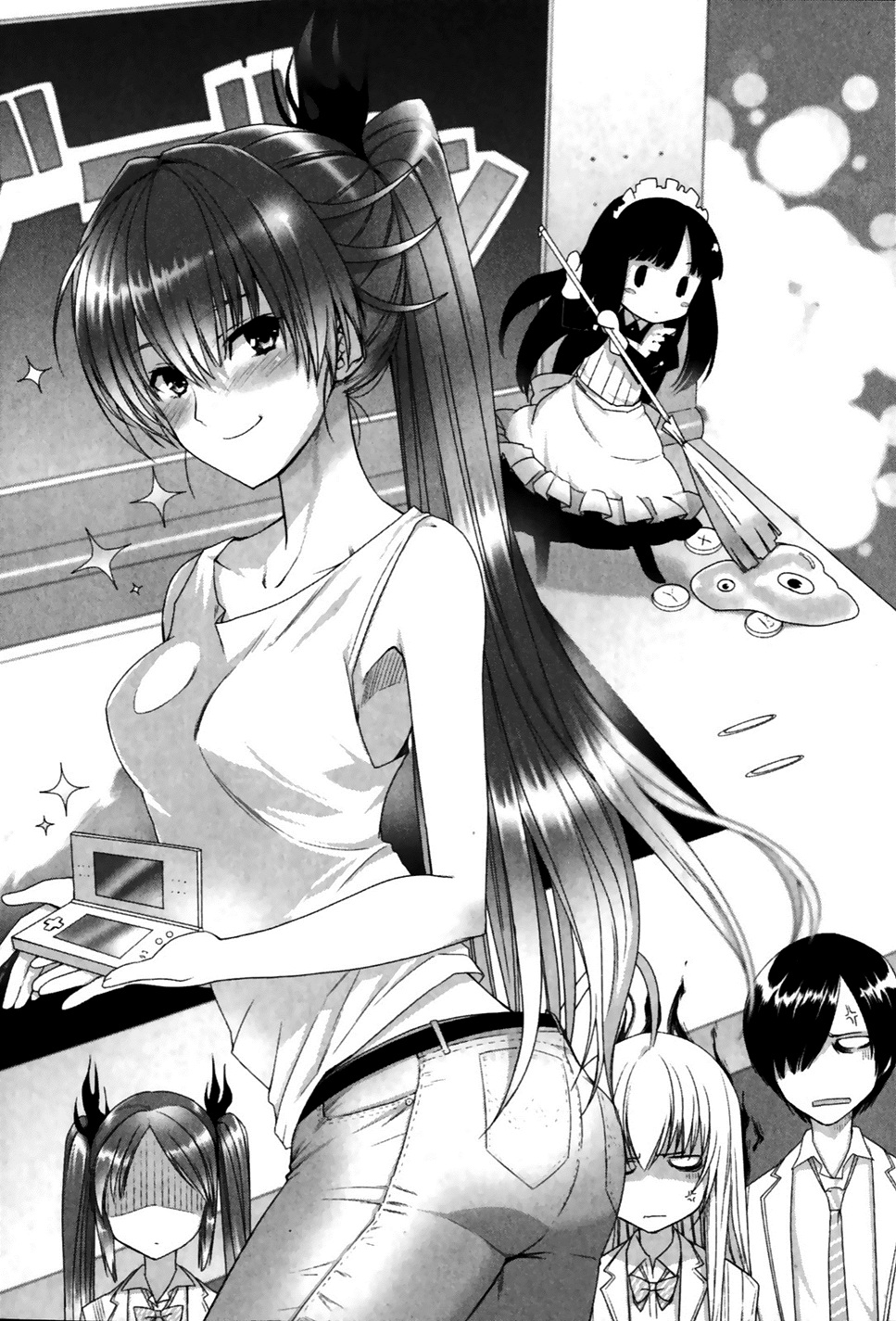
On a related note, the maid that appears here is based on Tekeri (テケリ) from "Uchi no Meido ha Futeikei" (うちのメイドは不定形), "My Maid is Amorphous", a Cthulhu Mythos inspired light novel written by Shizukawa Tassou (静川龍宗) and published in 2010. Images for reference:
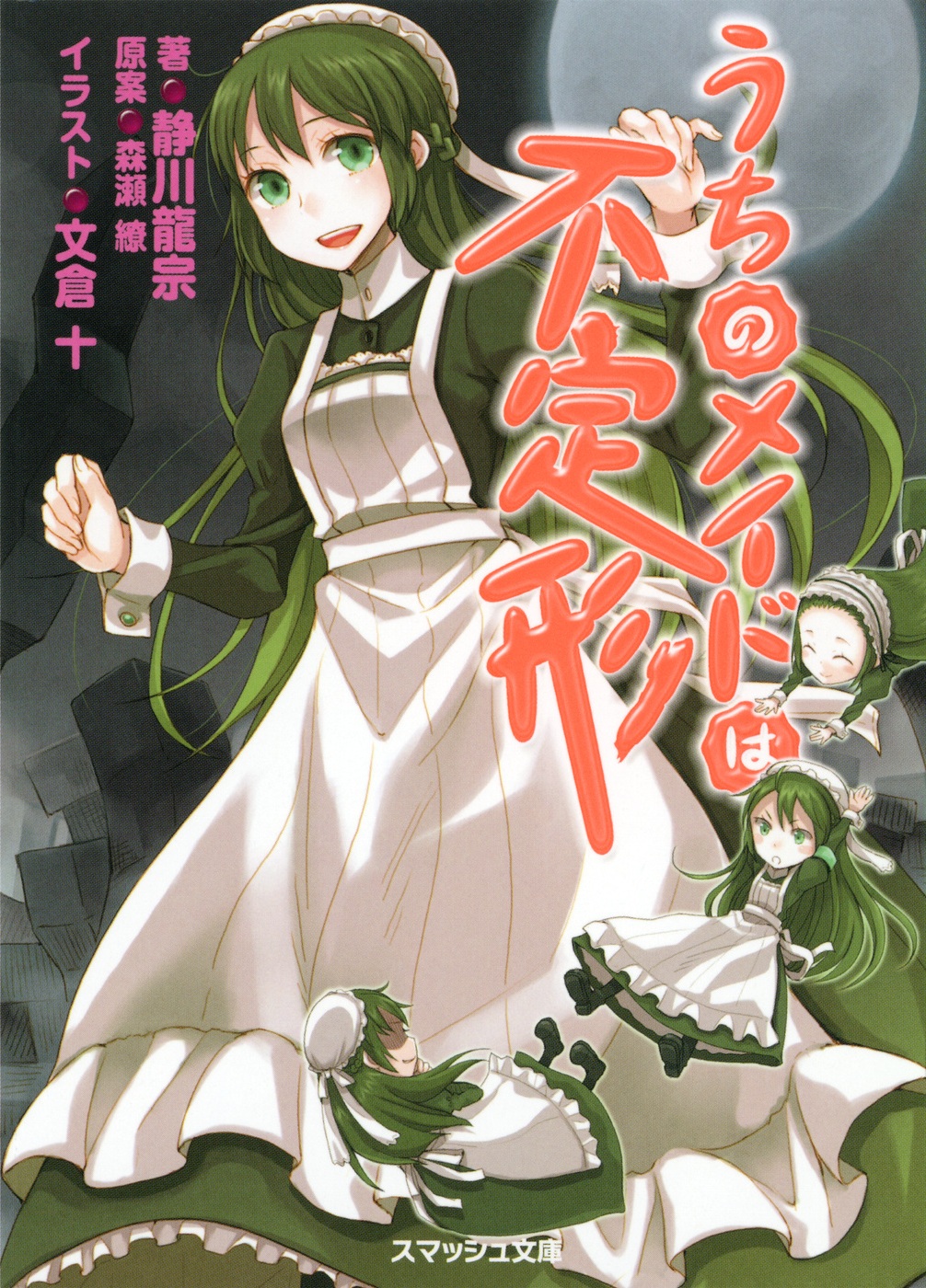
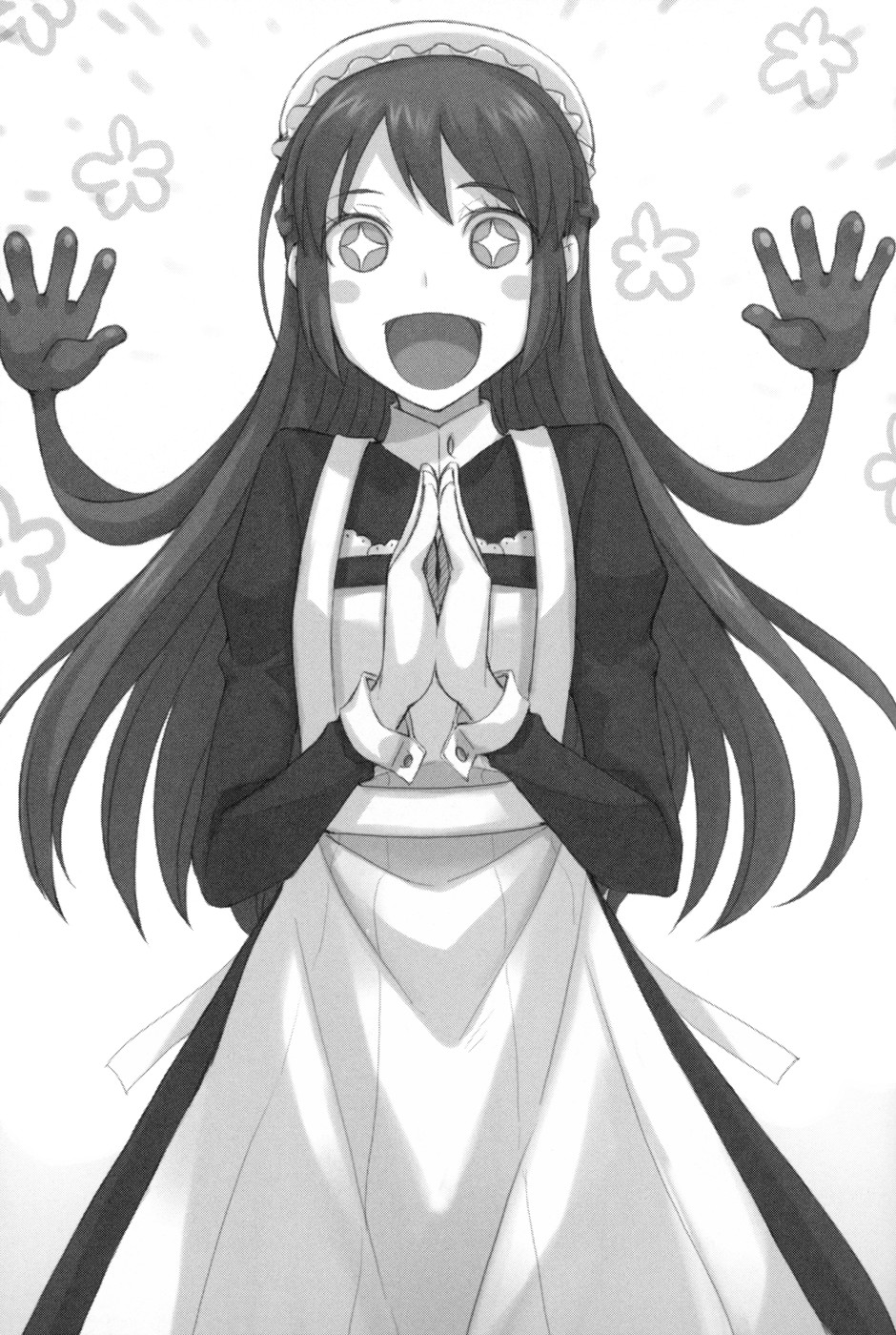
In addition to the visual similarity, the connection is made clear by the following line on page 270 of volume 6 of the "Haiyore! Nyaruko-san" light novel series.S5 When Cthune (クー音 Kuune), Cthuko's cousin, shows off what she bought, she says,
「どう、これ! すごいでしょ! 『テケリ』だよ! 地球の日本、それも蜷川区でしか配信されない伝説のモンスターなんだよ!」To explain, in "Uchi no Meido ha Futeikei", Tekeri is a shoggoth from the Cthulhu Mythos. In "At the Mountains of Madness", a story written by H. P. Lovecraft and first published in 1931, a shoggoth is described to be "a shapeless congeries of protoplasmic bubbles". This is why Tekeri is described as "futeikei" (不定形), "amorphous", in the title. Her name is based on "Tekeli-li", a phrase shoggoths are known to endlessly repeat in the Cthulhu Mythos. Ninagawa-ku (蜷川区), Ninagawa Ward, is the name of the fictional city that is the setting of this light novel.
"What do you think of this! Isn't it amazing! It's 'Tekeri'! It's a legendary monster that isn't sold anywhere except in the Ninagawa Ward of Japan on Earth!"
"It's very important, so I asked twice!" (13:37)
The Japanese line is "Daiji na koto nano de nikai iimashita!" (大事なことなので二回言いました!). This is a repeat of a reference in episode 1 at 11:14. This is referencing a popular Japanese TV commercial for the health product "Jokin ga Dekiru Tafudento" (除菌ができるタフデント), "Bacteria Eradicating Tough Dent", tablets used for cleaning dentures sold by the Kobayashi Pharmaceutical Company (小林製薬株式会社). The original line goes, "Daiji na koto nano de nidai iimashita yo" (大事なことなので二度言いましたよ), which translates to "I said it twice because it's important!". Video reference: https://youtube.com/watch?v=2cHtNezvK3E
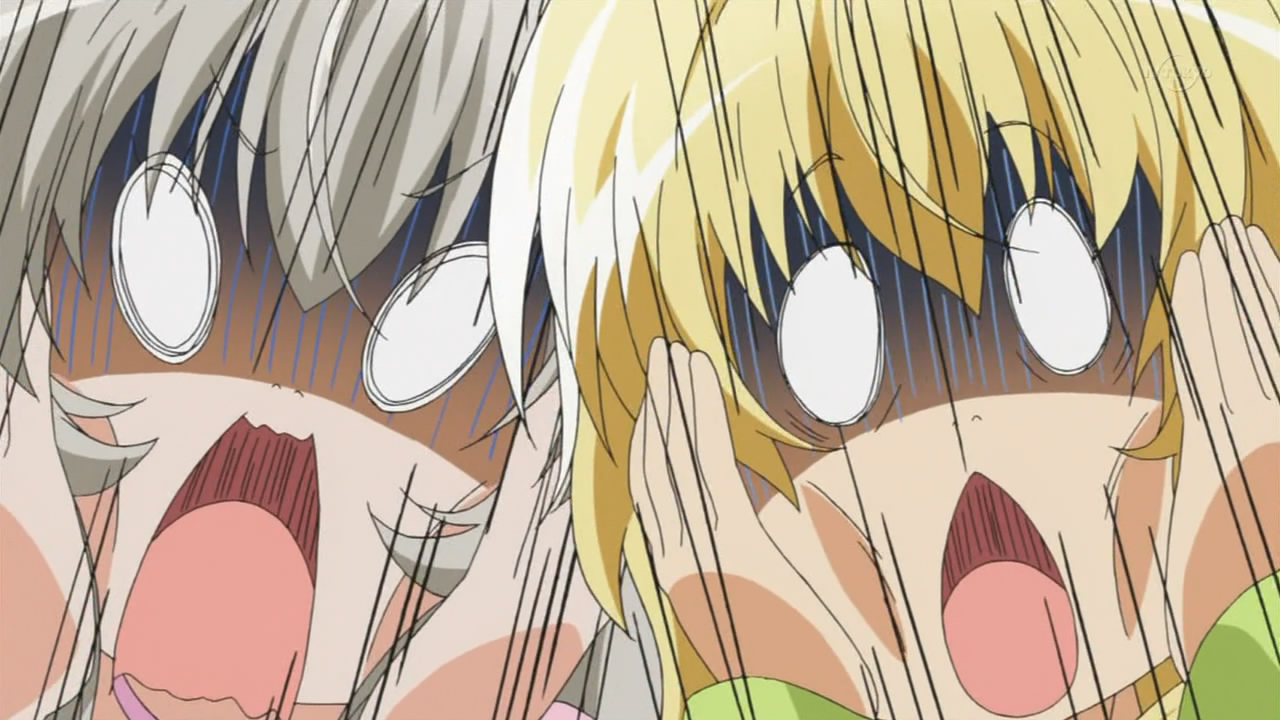
(14:01)
Nyaruko and Hasta's poses and expressions are referencing "The Scream", a painting painted by Edvard Munch in 1893. Image for reference:
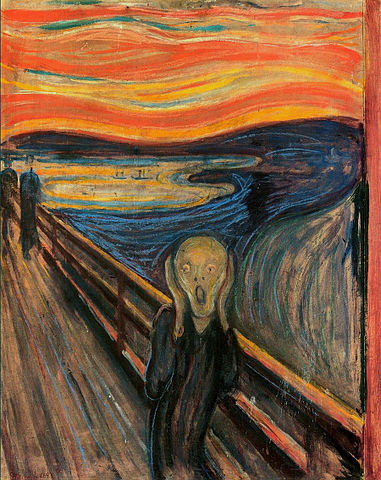
Source of image: https://en.wikipedia.org/wiki/File:The_Scream.jpg
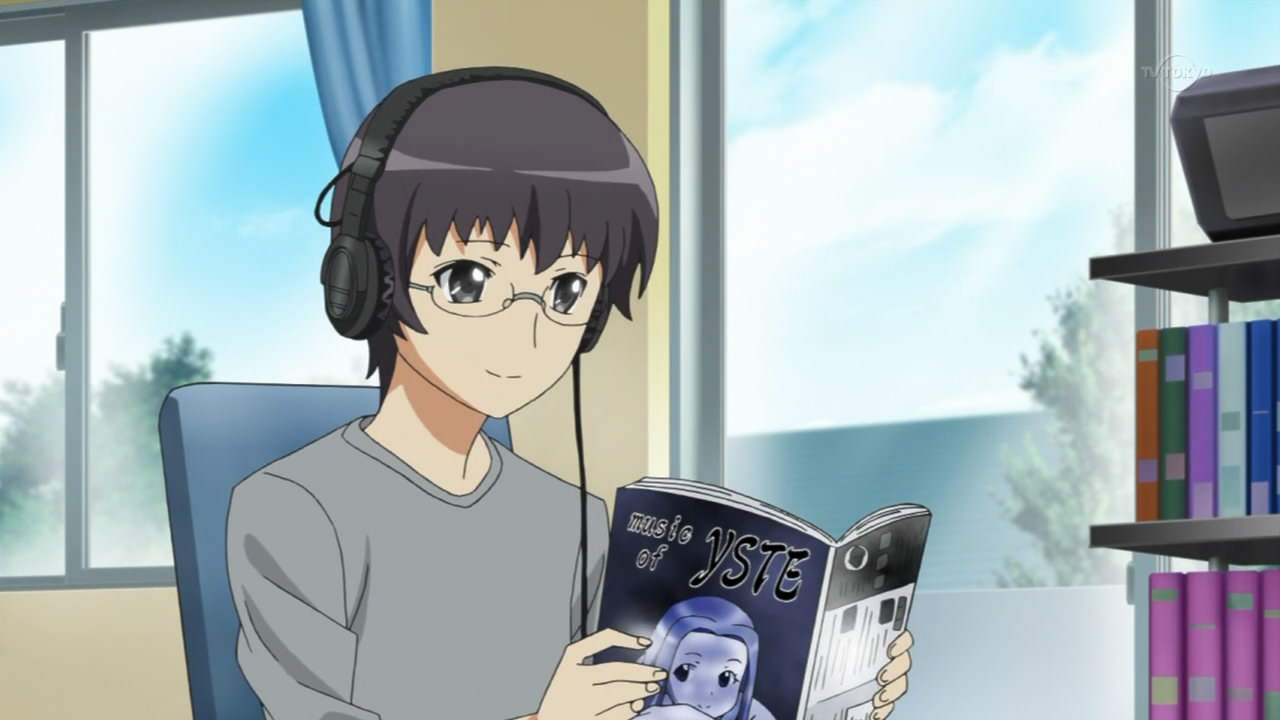
(14:45)
This is the book that Yoichi is reading.
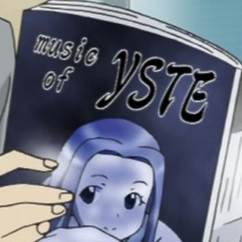
The title of the book is "music of YSTE". This is referencing "Song of Yste", a book of occult lore from the Cthulhu Mythos. It is mentioned in "The Abyss", a story written by Robert A. W. Lowndes and first published in 1941.S2
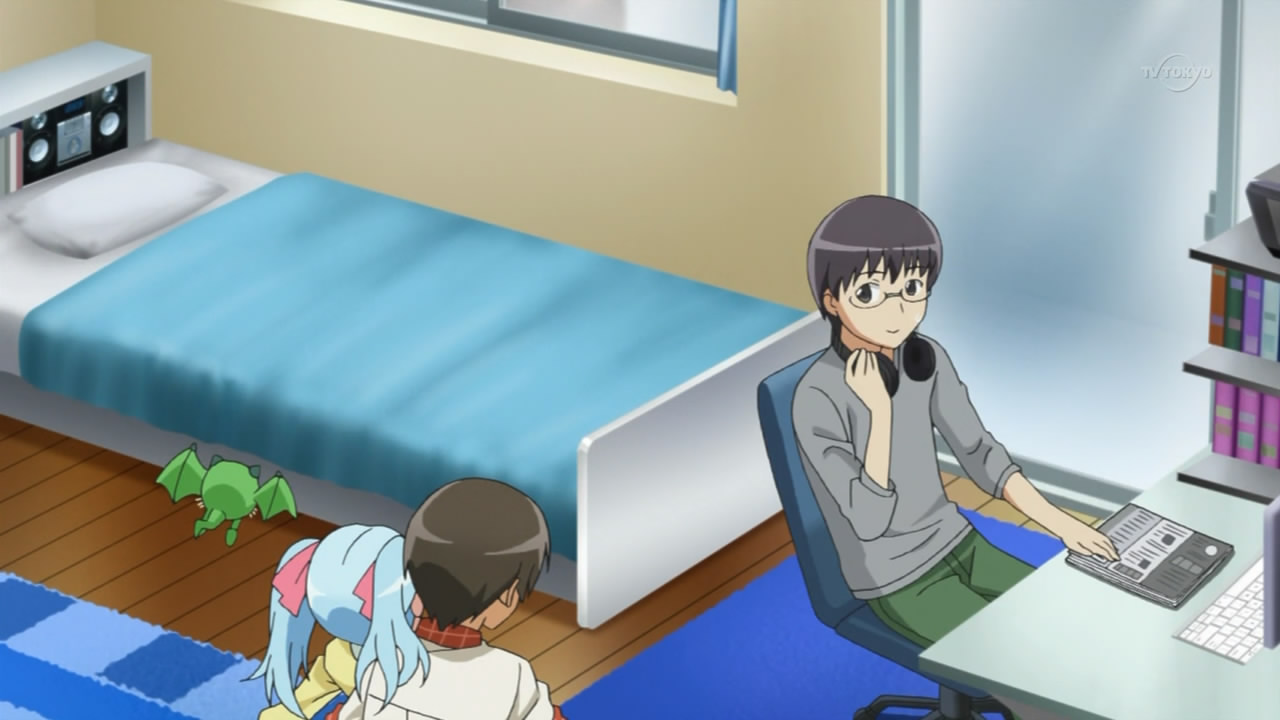
(14:52)
An iMac desktop computer and an Apple Keyboard can be seen to the right.S1 Images for reference:

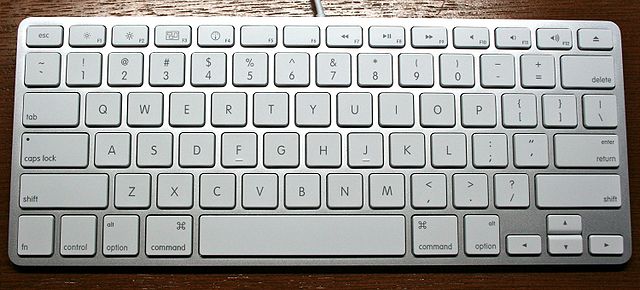
Image sources:
https://en.wikipedia.org/wiki/File:Imac_16-9.png
https://en.wikipedia.org/wiki/File:Apple_iMac_Keyboard_A1242.JPG
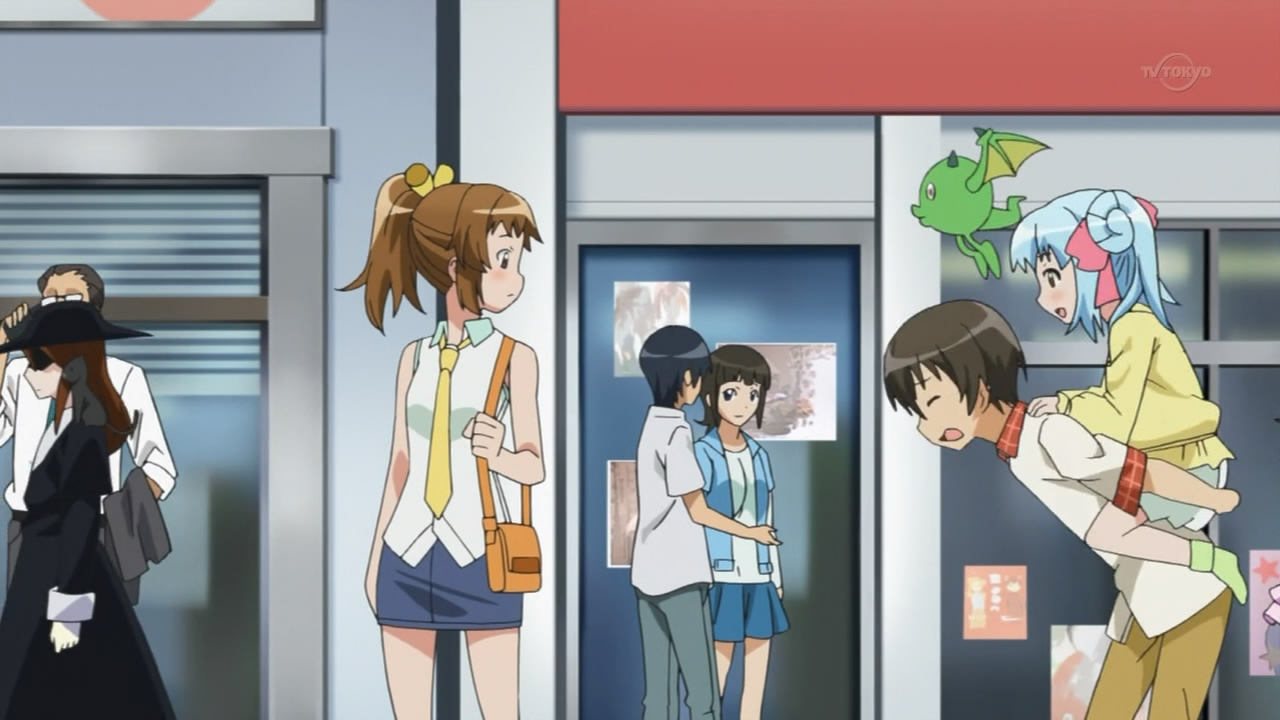
(15:09)
There are two references here:
* The girl dressed in black that appears on the left strongly resembles Alicia Y. Armitage (アリシア・Y・アーミティッジ) from "ALICIA.Y" (アリシア・Y), a manga series written by Gotou Juan (後藤寿庵) and published in 1994. Similarly, the black cat on her shoulder resembles Alicia's partner, Nyarl (ナイアール), whose true identity is Nyarlathotep.S1 Images for reference:

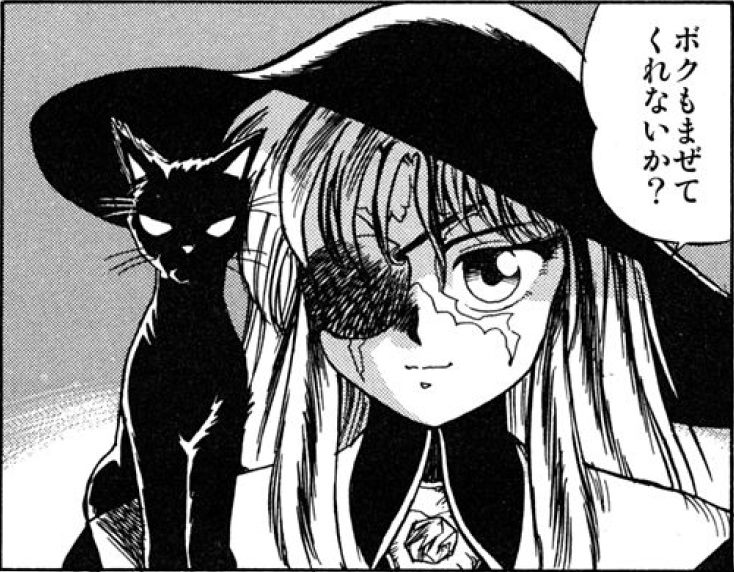
* The girl says "Chii suutaro ka" (血ぃ吸うたろか), which roughly means "Shall I suck your blood?". This is a gag line used by Japanese comedian Hazama Kanpei (間寛平).S2
Radio playing in the background (15:30)
The radio show that can be heard playing in the background during this entire scene is an excerpt from an episode of the Japanese radio show "A&G; SUUPAA RADIO SHOW ~AniSupa!~" (A&G; 超RADIO SHOW〜アニスパ!〜). The excerpt is of the hosts of the show reading a letter submitted by a listener going by the pen name "Ni dai me bishoujo" (二代目美少女), which translates to "Second Generation Beautiful Girl". It has been revealed that this letter was actually sent in by Matsuki Miyu (松来未祐), the voice actor of Cthuko. On a related note, Asumi Kana (阿澄佳奈), Matsuki Miyu (松来未祐), and Ootsubo Yuka (大坪由佳), the voice actors of Nyaruko, Cthuko, and Tamao, guest star on episode 425 of "AniSupa", which aired on May 26, 2012.S2 Here is a related article for reference (Japanese): http://mantan-web.jp/2012/05/26/20120526dog00m200010000c.html

(15:31)
As mentioned in episode 7 at 9:49, there are two references here:
* The name of Luhy's restaurant is Puti Kuti (プティ・クティ). This is the name of the mascot character from "Moe Moe Kutouruu Shinwa Jiten" (萌え萌えクトゥルー神話事典), "Lovely Cthulhu Mythos Encyclopedia", a book published in 2009.
* The creature that appears on the sign is referencing Cthulhu from the Cthulhu Mythos. In particular, the depiction here is based on the appearance of Puti Kuti from the book mentioned above. Image for reference:
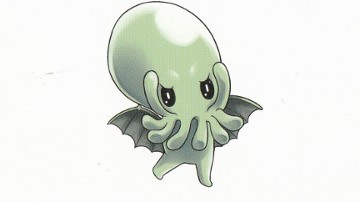
Source of image: http://f.hatena.ne.jp/servitors/20120524190732
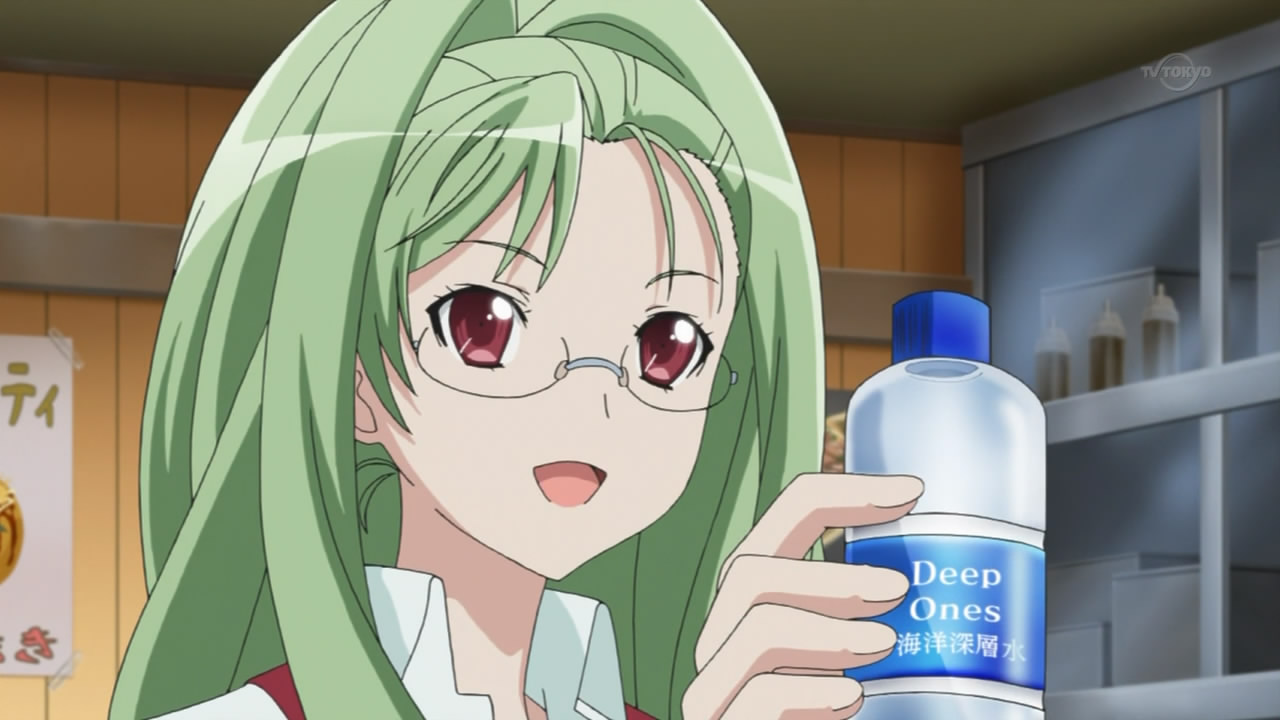
(15:47)
The label on the bottle that Luhy is holding reads "Deep Ones". This is referencing Deep Ones, a species of ocean dwelling creature in the Cthulhu Mythos.
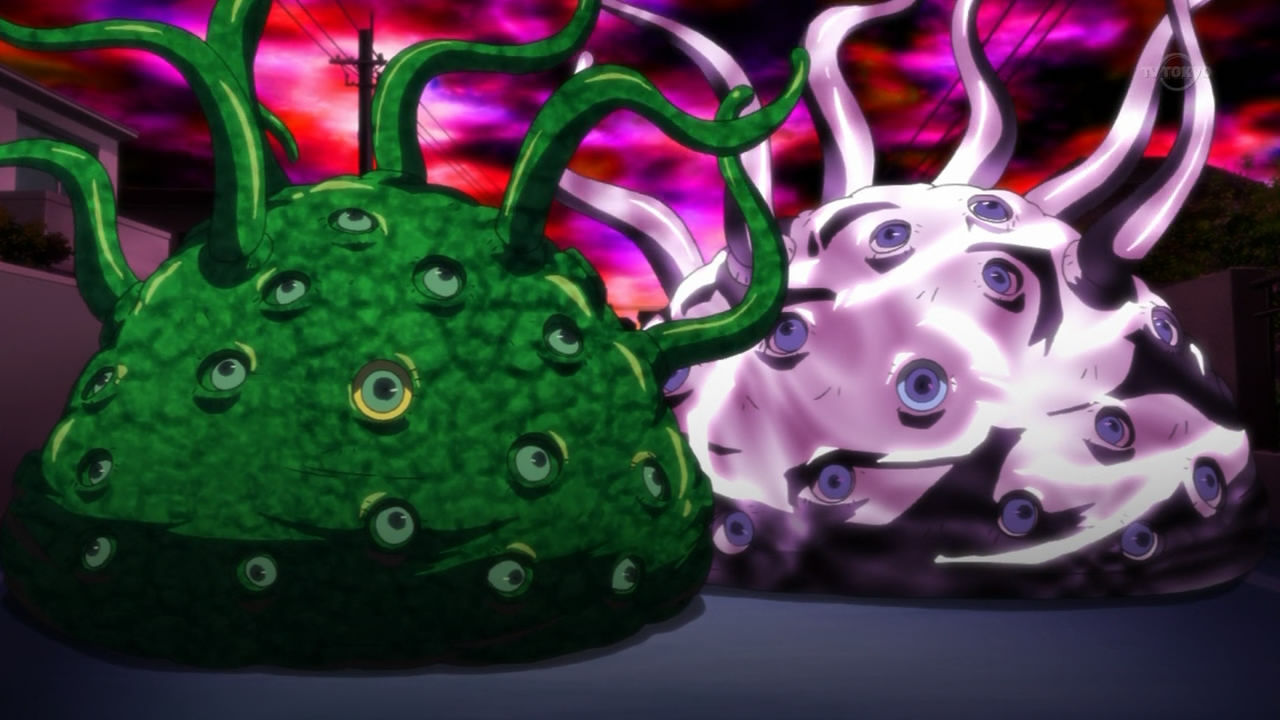
"I did not expect to encounter Shoggoth here!" (16:55)
As mentioned earlier, Shoggoth is a species of creature in the Cthulhu Mythos.
"They're stray Shoggoths." (17:06)
"Weak and quick to run. An extremely rare character." (17:08)
"This is an opportunity to gather experience points!" (17:22)
The term "hagure shogosu" (はぐれショゴス), "stray Shoggoth", is referencing "hagure metaru" (はぐれメタル), "stray metal", a recurring monster in "Dragon Quest" (ドラゴンクエスト), a series of video games released starting from 1986. It first appeared in "Dragon Quest II: Luminaries of the Legendary Line" (ドラゴンクエストII 悪霊の神々), a video game released by Enix (エニックス) in 1987. In the series, this monster has low health, often immediately runs away when encountered, appears very rarely, and gives out a large amount of experience points when it is defeated.
"Cyclone... Metal..." (17:13)
"Saikuron" (サイクロン), "Cyclone", and "Metaru" (メタル), "Metal", are referencing Kamen Rider W from "Kamen Rider W" (仮面ライダーW), a Japanese TV show about a masked super hero that aired from 2009 to 2010.S1 In the show, Kamen Rider W has a form called "Saikuron Metaru" (サイクロンメタル), "Cyclone Metal". In addition, one Shaggoth is green and one Shaggoth is silver, which is referencing the half green and half silver color scheme of this form. Image for reference:
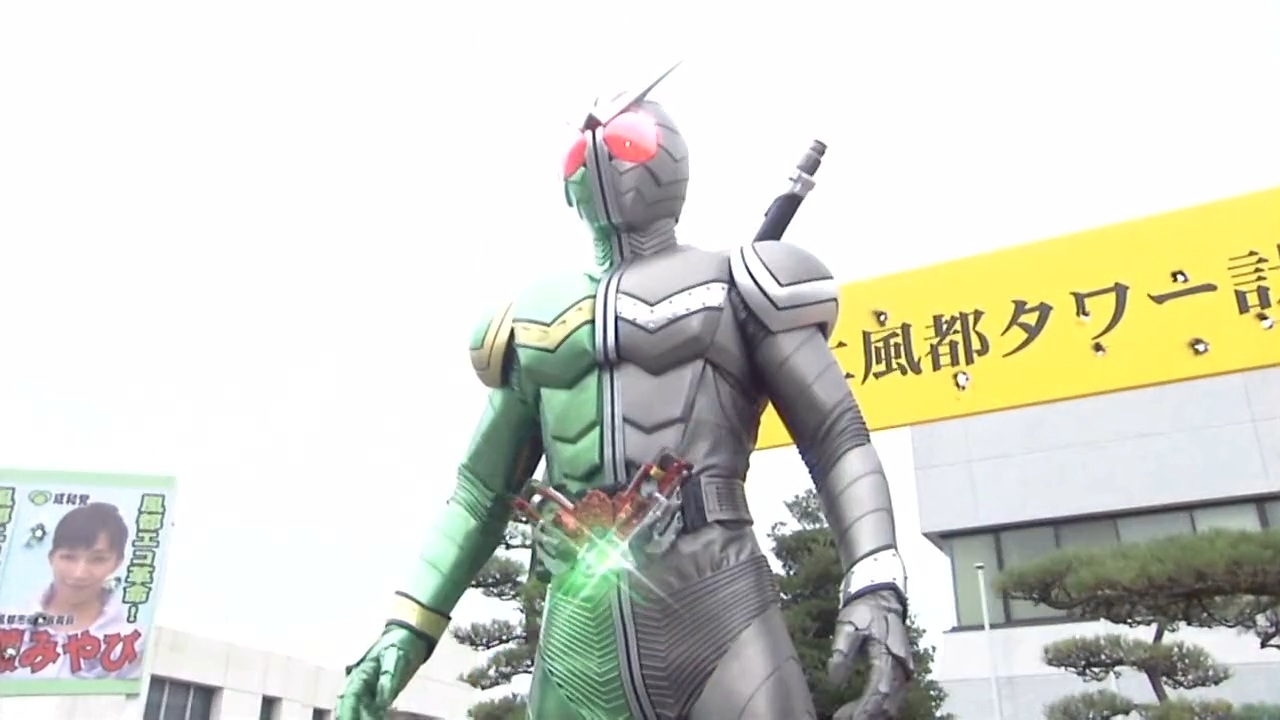
"Spew your guts!" (17:50)
The Japanese line is "Harawata wo buchimakenasai!" (腸をぶちまけなさい!). This is referencing a line said by Tsumura Tokiko (津村斗貴子) in "Busou Renkin" (武装錬金), "Arms Alchemy", a manga series written by Watsuki Nobuhiro (和月伸宏) and published from 2003 to 2006.S1 On a related note, an anime adaptation of this series aired from 2006 to 2007 and was animated by Xebec (ジーベック), the same studio that animated "Haiyore! Nyaruko-san". The original line goes, "Zoumotsu wo buchimakero!" (臓物をブチ撒けろ!), which translates to "Spew your guts!". Image for reference:
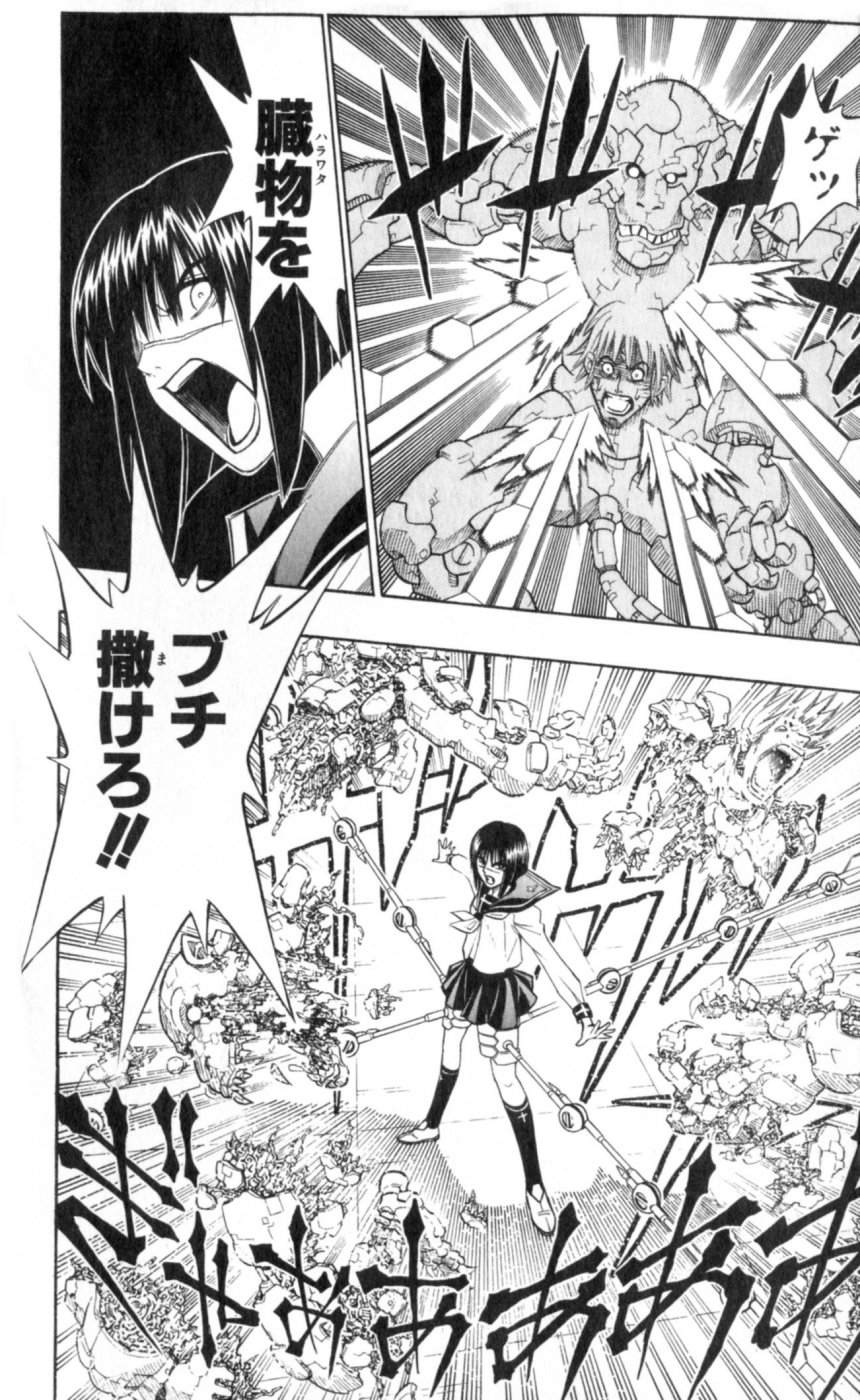
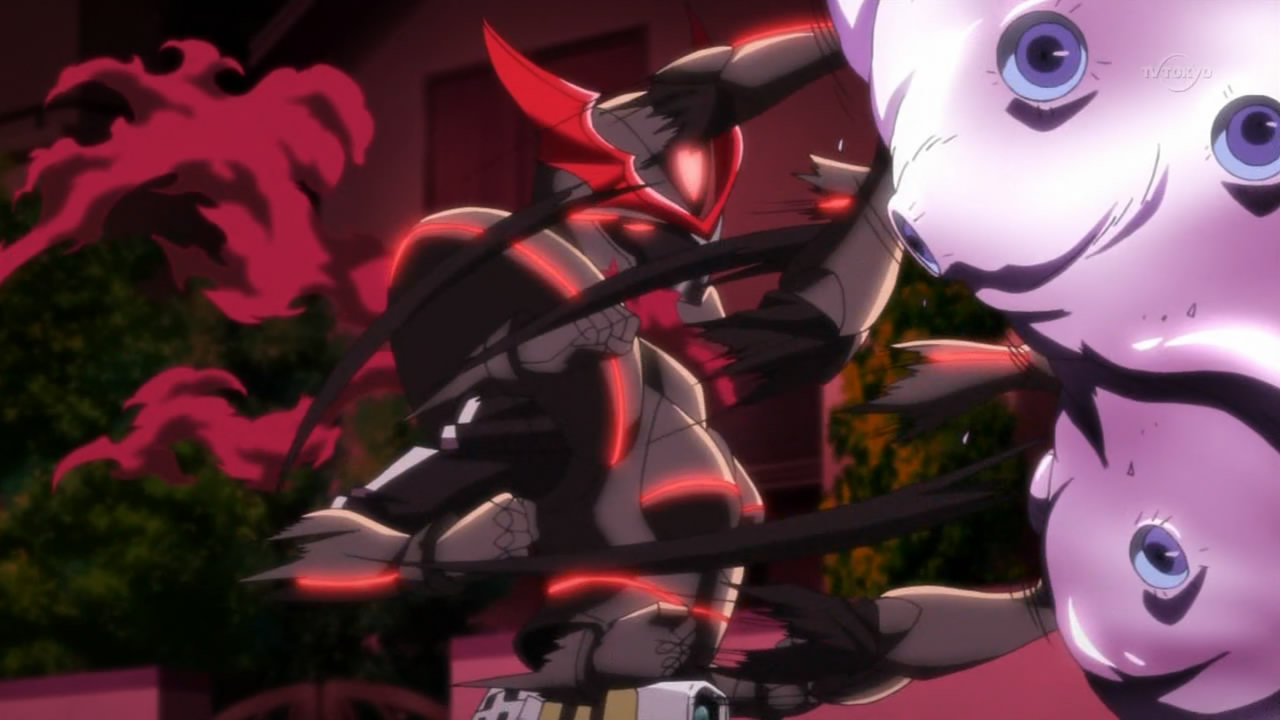
(17:54)
Nyaruko rapidly punches while shouting, "Atatatatata!" (あたたたたた!). This is referencing Kenshirou (ケンシロウ) from "Hokuto no Ken" (北斗の拳), "Fist of the North Star", a manga series written by Buronson (武論尊) and published from 1983 to 1988. Kenshirou shouts in this manner when he attacks. Image for reference:
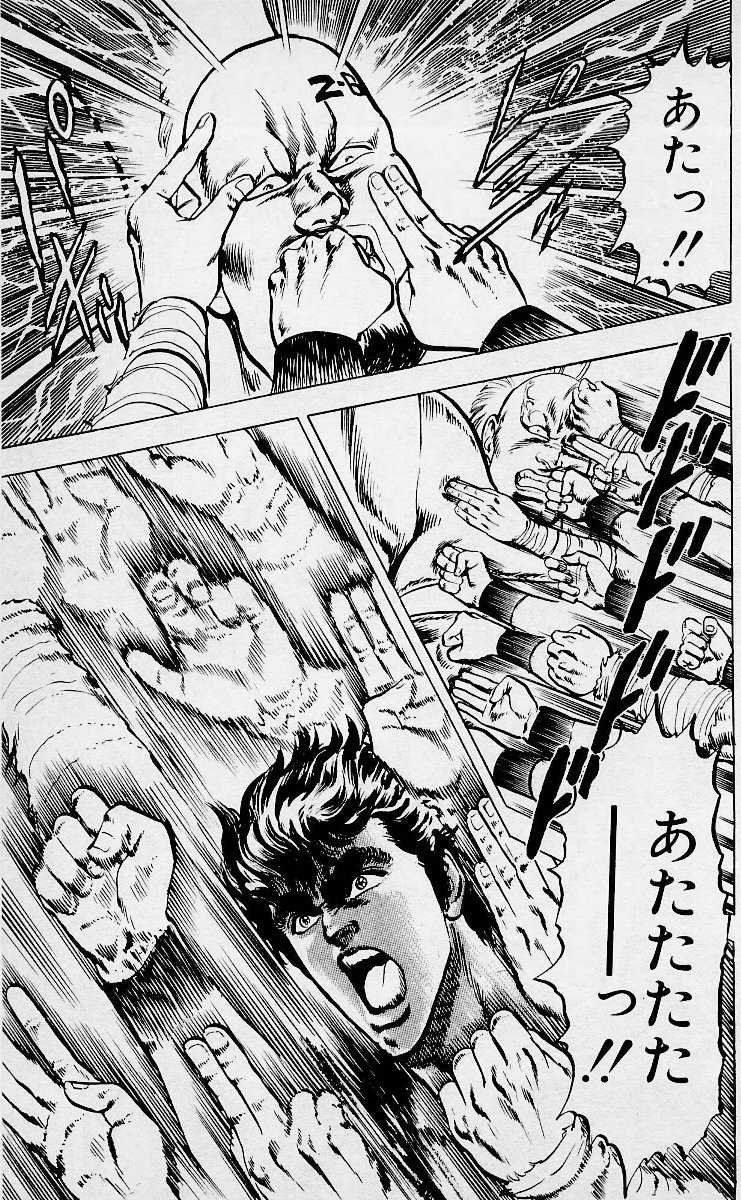
"The end meow" (17:57)
The Japanese line is "Ji endo nyan" (ジ・エンドにゃん). This a line in the lyrics to "Happii Nyuu Nyaa" (はっぴぃ にゅう にゃあ), "Happy New Nyaa", a song sung by Itou Kanae (伊藤かな恵), Iguchi Yuka (井口裕香), and Taketatsu Ayana (竹達彩奈) and released in 2010.S2 This song is the first opening theme song to "Mayoi Neko Oobaaran!" (迷い猫オーバーラン!), "Stray Cat Overrun", an anime series that aired in 2010. On a related note, the person who wrote the script for episode 11 of "Haiyore! Nyaruko-san", Kimura Noboru (木村暢), also wrote the script for several episodes of this series.
"Venom." (18:15)
The Japanese line is "Benon" (ベノン). This is referencing "Benon" (爆霊地獄), "Venom", a spell used by Dark Schneider (ダーク・シュナイダー) in "Bastard!! The Dark God of Destruction" (BASTARD!! -暗黒の破壊神-), a manga series written by Hagiwara Kazushi (萩原一至) and first published in 1988. Image for reference:
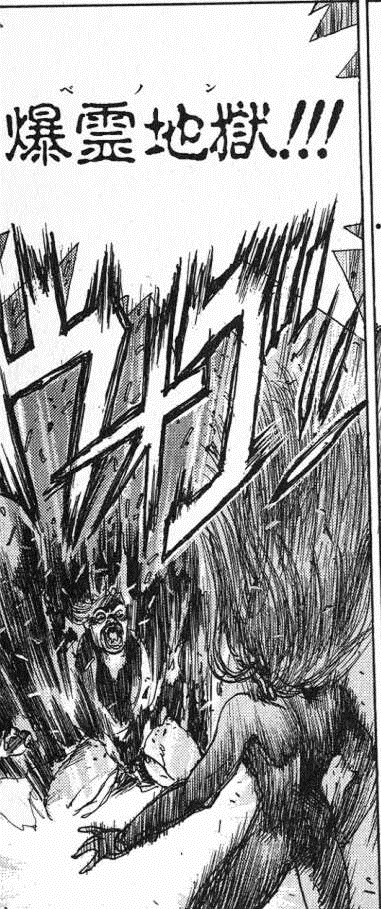
"Fire power up, Fever." (18:21)
The Japanese line is "Karyoku appu fiibaa" (火力アップフィーバー). This is referencing "Weiku Appu Fiibaa" (ウェイクアップフィーバー), "Wake Up Fever", an attack used by Kamen Rider Kiva in "Kamen Rider Kiva" (仮面ライダーキバ), a Japanese TV show about a masked super hero that aired from 2008 to 2009.S3
Nyaruko's tune (18:32)
The tune that Nyaruko sings at this time is referencing the level up sound effect from "Dragon Quest" (ドラゴンクエスト), a series of video games released starting from 1986. Video for reference: https://youtu.be/HWXjt0c1xd8?t=16s
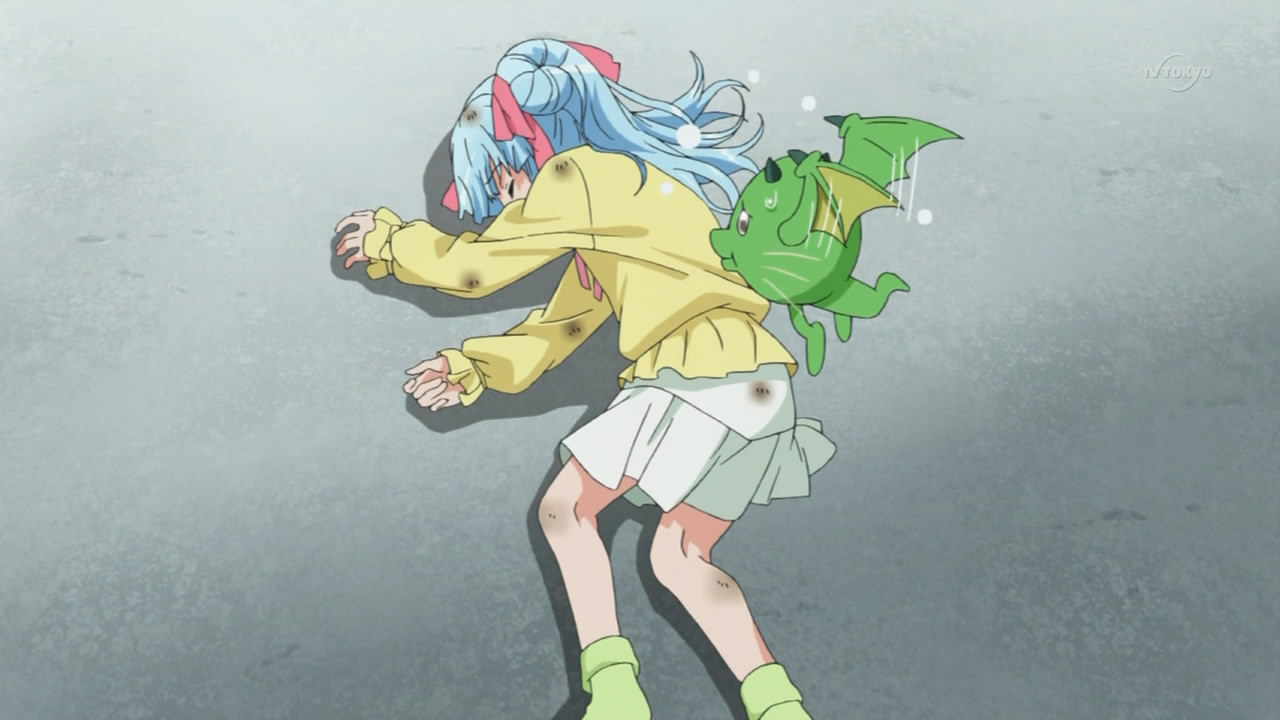
(18:50)
Ghutatan's lying down state is referencing that of Yamcha in chapter 215 of volume 18 of "Dragon Ball" (ドラゴンボール), a manga series written by Toriyama Akira (鳥山明) and published from 1984 to 1995.S1 The series was later republished in 2002 as 34 volumes, rather than the original 42. In this republication, the scene with Yamcha still occurs in chapter 215, but in volume 15. Image for reference:
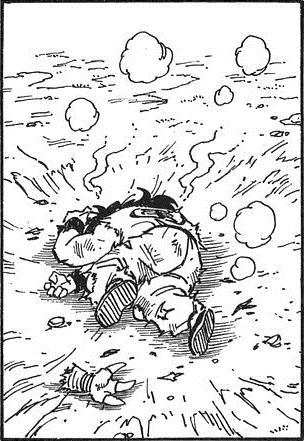
On a related note, the official anime website for "Haiyore! Nyaruko-san", http://nyaruko.com/, used to show an image of the full cast. Image for reference:

However, to reflect the end of episode 11, the website now has a picture of Mahiro alone, with the rest of the cast missing.S1 Image for reference:
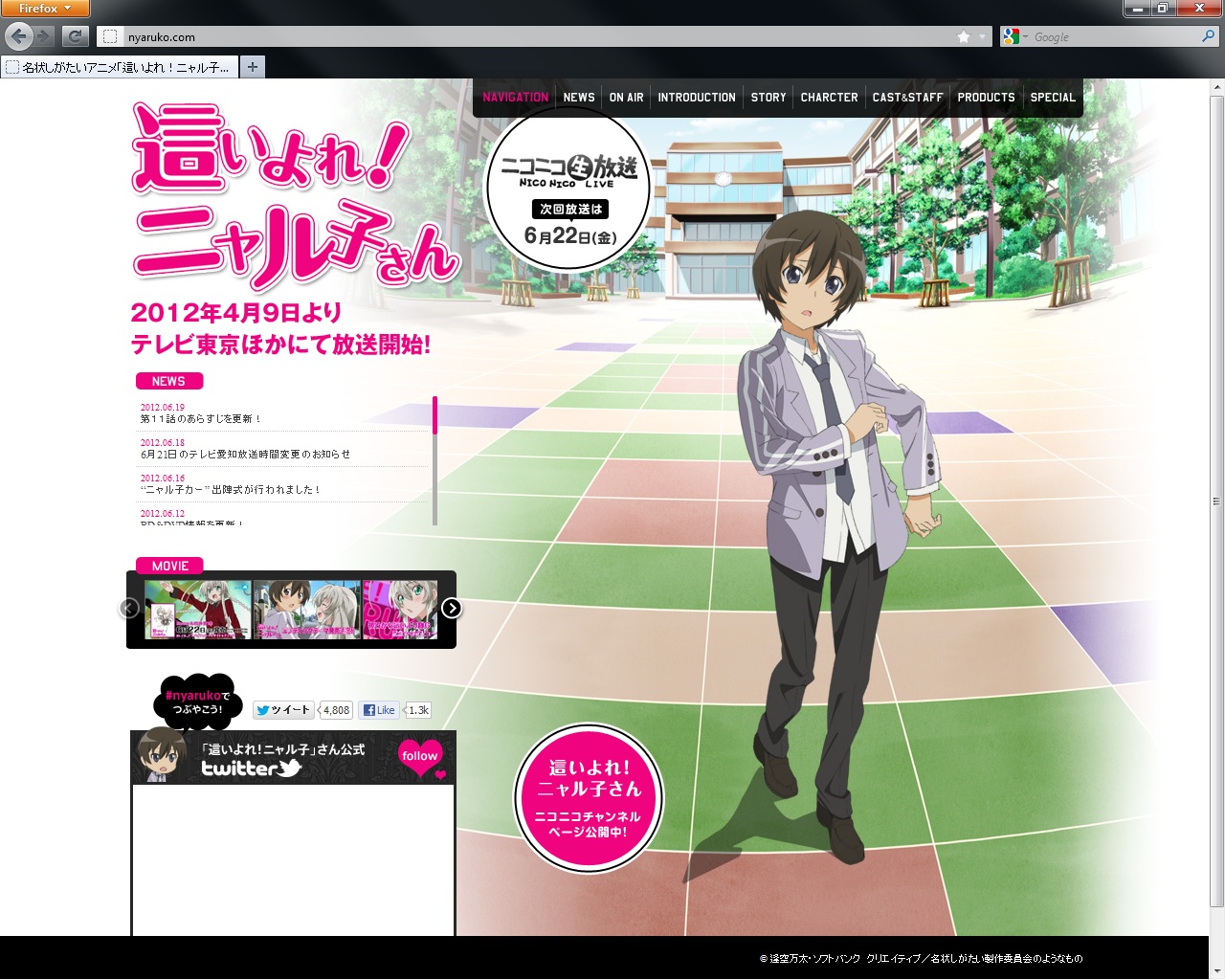
List of sources:
S1. Comments on this post
S2. A post at Steman Blog (ステマブログ)
S3. Japanese Nyaruko References Wiki (這いよれ! ニャル子さん 元ネタwiki)
S4. A blog by servitors about Cthulhu Mythos inspired works (クトゥルー/クトゥルフ神話作品発掘記)
S5. A blog post by T.Y. (Japanese)
Thanks to everyone who contributed! This list wouldn't be nearly as long without you all. See you next episode!
情報を教えてくださって本当にありがとうございました!皆さんがいなかったら、このリストはぜんぜん長くありません。またこの次までね!
Last updated July 26, 2012
Sitemap
Home
